No Results Found
The page you requested could not be found. Try refining your search, or use the navigation above to locate the post.
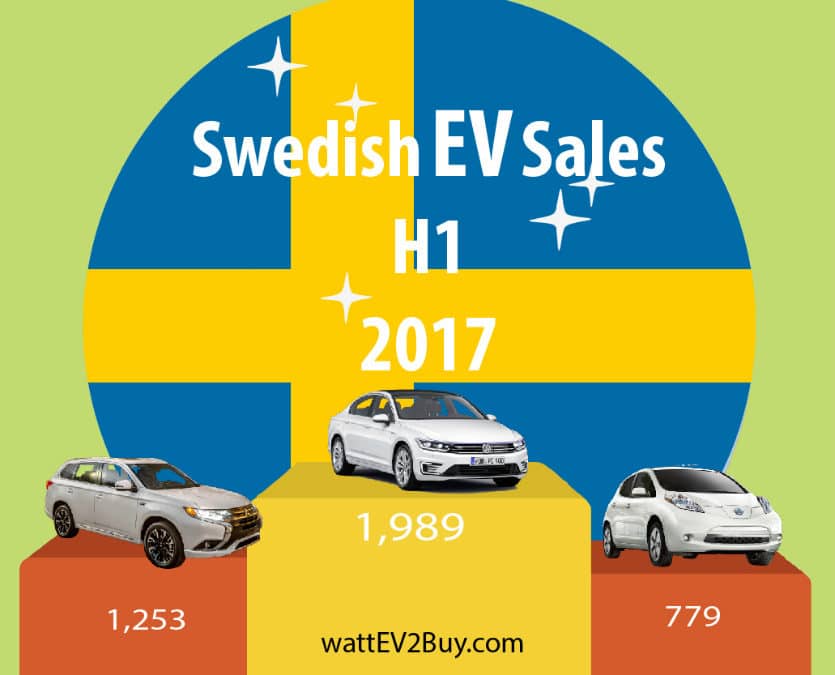
We look at the Top brands and models, the gainers and losers and how the battle between battery electric (BEV) and plug-in hybrid (PHEV) technologies play out in the summary of Sweden EV Sales H1 2017.
The highlights for Swedish electric car sales in H1 2017 was:
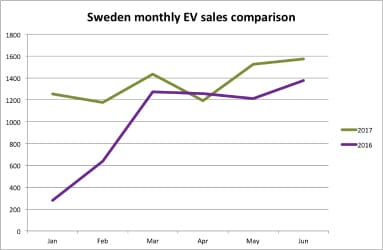
The Top 3 EV brands in Sweden for H1 2017 were VW, new entrant Mitsubishi and BMW. Most EV brands except Volvo and Peugeot showed gains in units sales compared to H1 2016. Hyundai entered the Swedish market with its Hyundai Ioniq BEV. Initial sales for the Ioniq was below average in a market which has a preference for plug-in hybrid electric vehicles. Toyota re-entered the market with the new Prius but failed to get the same traction as it did in other markets. Tesla and Mitsubishi nearly doubled their sales from 2016. Sweden is on of the few markets where Mitsubishi showed positive growth with the aging Mitsubishi Outlander PHEV in 2017 and now makes up 23.24% of all EV registrations in Sweden. BMW maintained its third overall position with the support of its 330e, 225xe, and X5 xDrive models, more than compensating for waning sales in the BMW i3 model series. VW held on to the top spot, mostly due to the VW Passat GTE which accounted for 25% of all EV sales in Sweden during H1 2017.
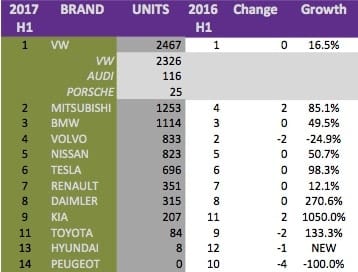
Ten new EV models entered the Swedish EV market in the comparison between H1 2016 and H1 2017. Of the ten new EV models, eight were plug-in hybrids, and only the Tesla Model X made it on to the Top 10 list. Volvo launched two new plug-in models at the end of May in its home market, the Volvo XC60 T8 and Volvo S90 T8 PHEV. The XC60 sold 44 units and the larger S90 31 units. The Nissan Leaf still performed well considering the upgrade is expected early 2018. Most of the Mercedes-Benz models fared well except for its larger S550 and GLE550 models. The Daimler company could however not compete with its compatriot, BMW, who had more models in the smaller end of the scale. The BMW 330e, BMW i3, and BMW 225xe Active Tourer sold 813 units while the Mercedes-Benz B250e and Mercedes-Benz C350e could only muster a combined 130 units. The Tesla Model S still performed well in Sweden as opposed to the general trend where we see the sales flattening out in its main markets.
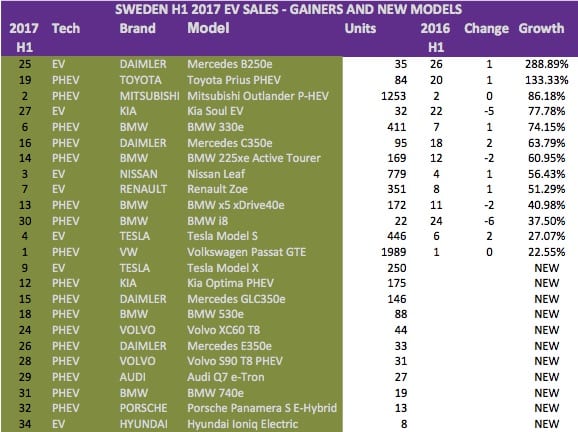
Volvo was the big loser in Sweden during the first half of 2017 despite having a home ground advantage and bringing two new models to market, albeit only in late May. Volvo’s two mainstay plug-in electric cars, the Volvo XC90 T8 and Volvo V60 PHEV, lost nearly a third of their respective sales to brands such as VW, BMW, and Mercedes-Benz.
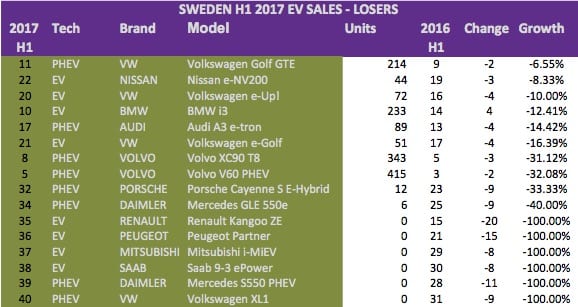
Sweden has a definite preference for plug-in hybrid electric vehicles. Of the ten new models released since the first half of 2016 in Sweden, eight were PHEVs. A total of 5,850 plug-in hybrid vehicles were sold, comprising 72% of the market while only 2,301 pure electric models were sold during the same period. The percentage breakdown of PHEV to BEV in H1 2017 is very similar to that of H1 2016, explaining why most new models released in Sweden were PHEVs despite a halving of the rebate on plug-in hybrids.
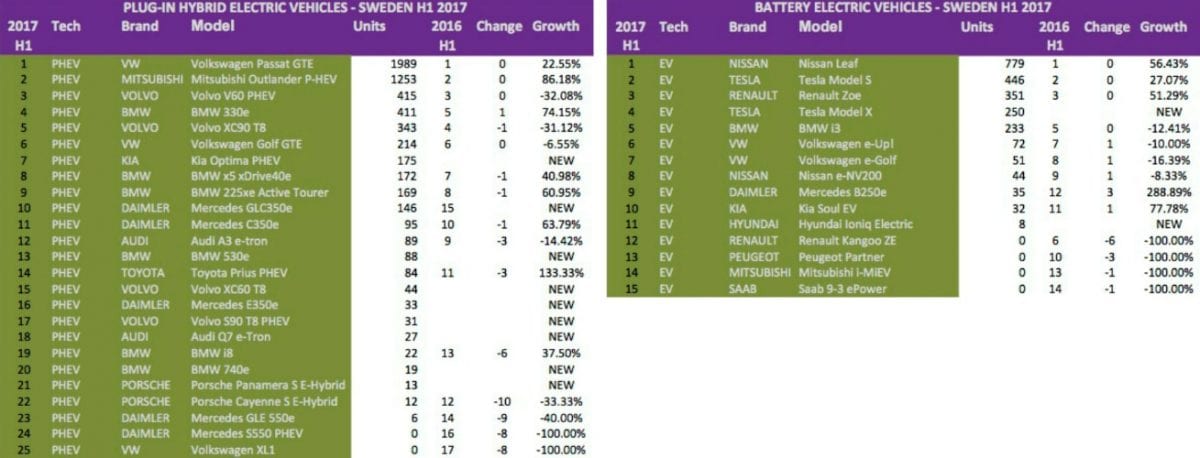
In conclusion, even at a 3.4% of the national fleet (Q4 2016), electric vehicle sales in Sweden remains low compared to its neighbor Norway, which has an EV penetration of close to 30% (Q4 2016). The sluggish performance is linked to the Swedish EV incentive program which has been erratic, linked to a fixed amount of funding which has been depleted a couple of times. Also, the Swedish EV buyer does not get his/her rebate at the point of sale. The Swedish Transport Agency contacts owners after the purchase of the vehicle requesting the completion of a paper process after which they receive the rebate. The rebate of 40,000 kroner (~ $4,500) applied to BEVs and PHEVs up to October 2016 at which time it was halved for PHEVs.
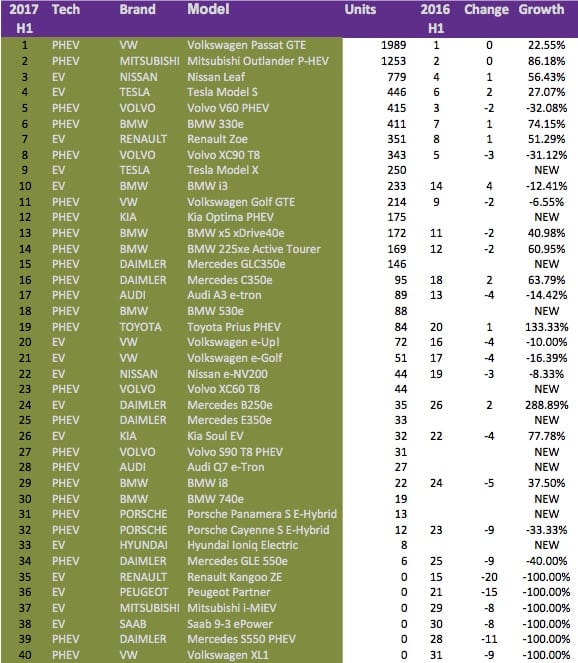
Base data supplied by EV Sales, all calculations, and data representations by wattEV2Buy.
Be sure to check out our new presentation of all EVs since 2010 to gain great insights on all auto brands and their electric vehicle strategies. We have also created presentations per technology type BEV, PHEV, and FCEV.
The page you requested could not be found. Try refining your search, or use the navigation above to locate the post.
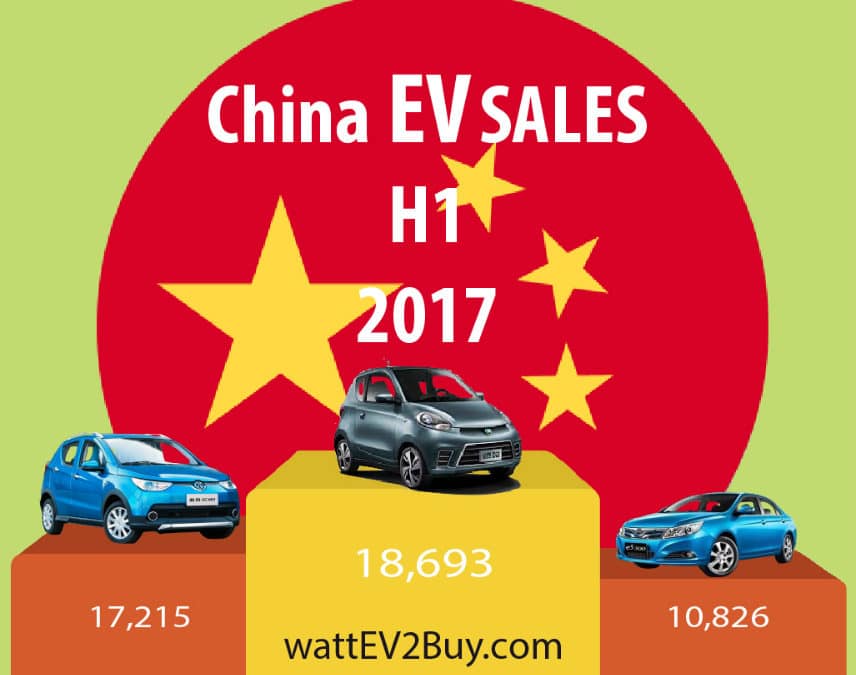
We look at the Top brands and models, the gainers and losers and how the battle between battery electric (BEV) and plug-in hybrid (PHEV) technologies play out in the summary of China EV Sales H1 2017.
The highlights for Chinese electric car sales in H1 2017 was:
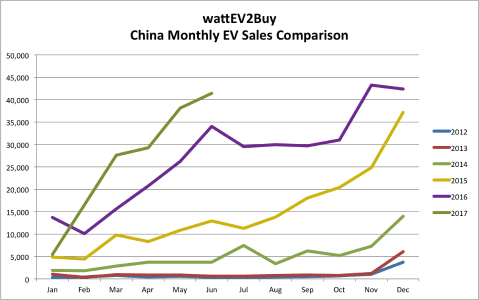
The Top 3 EV brands in China for the first half of 2017 were BYD, BAIC, and Zhidou. Although BYD hung on to its first place, it sees its lead evaporate. BYD hardly registered any sales in the January 2017, and lost sales in its top performing Qin and Tang model ranges to competing new models from BAIC, Chery, and SAIC Roewe. BYD, one of the largest EV brands in the world, is seeing its position as China’s best performing EV brand challenged as it lost over 20% of its sales compared to 2016, while its competitor BAIC more doubled its sales. BAIC benefited from exciting new models entering the market in the last 12 months, with its small hatch, the BAIC EC180 being a top performer for three of the six months ending up the second best selling EV for the semester. Smaller EVs, or City cars, have also performed very well with the popular Zhidou Geely D2 selling nearly 20,000 units. Another brand with small EV models, Zotye, was placed fourth due to the popularity of its Cloud 100, E200 and E30 models. Other Top 10 Chinese EV brands selling city cars included Chery and JMC, both placed in the Top 10. Although JAC brought the exciting JAC iEV6S small SUV to market it was not enough to withstand the onslaught of its peers, crashing out of the Top 3 to the eight position. Tesla also entered the Top 10 list with the Model X performing very well (please note the June 2017 Tesla data did not make it in time for our analysis, which would have aided the brand’s performance). Western brands such as Volvo, BMW through its local partner BMW Brilliance, Daimler and GM mostly gave up market share to Chinese-produced vehicles.
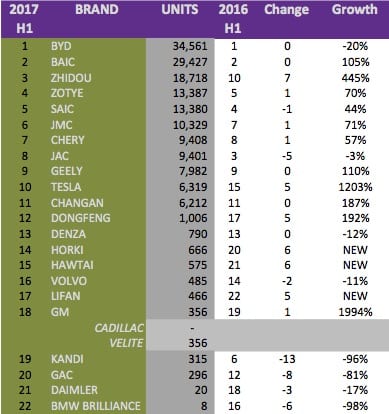
Twenty new EV models entered the Chinese EV market in the first half of 2017 but only three, the BAIC EC180, SAIC Roewe eRX5 and BYD Song DM, made it to the Top 10 list of electric vehicles in China. None of last years Top 5 could hang on to their positions with two of the new models, the BAIC EC180 and SAIC Roewe eRX5, entering the market with Top 5 positions within three months from being launched. Last year’s Top 3 EVs, the BYD Tang, BAIC E200, and BYD Qin all crashed out, with the BYD Tang the only model able to hold on to a Top 10 position. Plug-in Hybrid vehicles could only muster three positions in the Top 20 as small city EVs made up more than half of the units sold in 2017 to date. The popular SUV class accounted for 26% of the units sold in the Top 20 list of EVs in China while plug-in hybrids only accounted for 16% of all the EVs sold. New electric vehicle models made up 31% of all the EVs sold during the period under review.
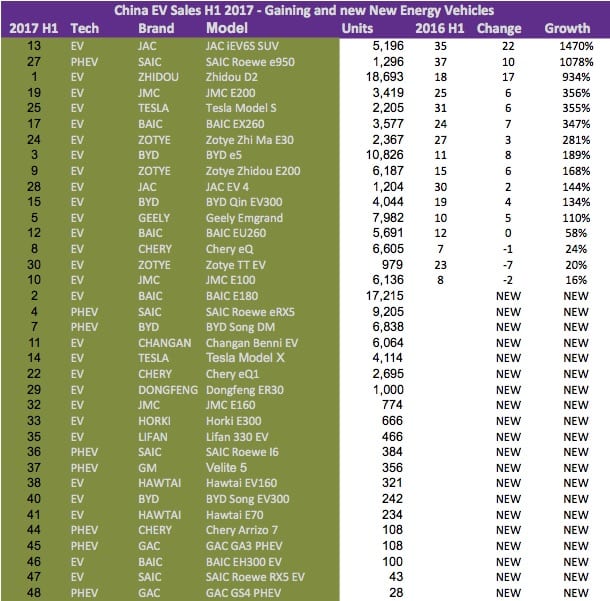
BYD’s ailing fortunes are clear in the list of losers for the first half of 2017 but another popular EV brand from 2016, Kandi, saw diminishing sales as its Kandi K17 Cyclone could not compete with the host of new small city cars entering the Chinese EV market. Clear again is the composition of plug-in hybrids and foreign brands in the list of the worst performing electric cars.
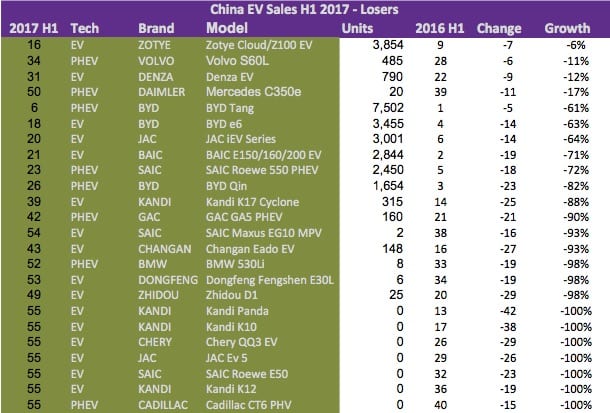
Plug-in hybrid models are losing the battle in China, strange though that 35% of the new models launched in the last 12 months are PHEVs. In the comparable period in 2016 plug-in electric vehicles made up 33% of all the units sold while the vehicle type only contributed to 16% of all sales in 2017.
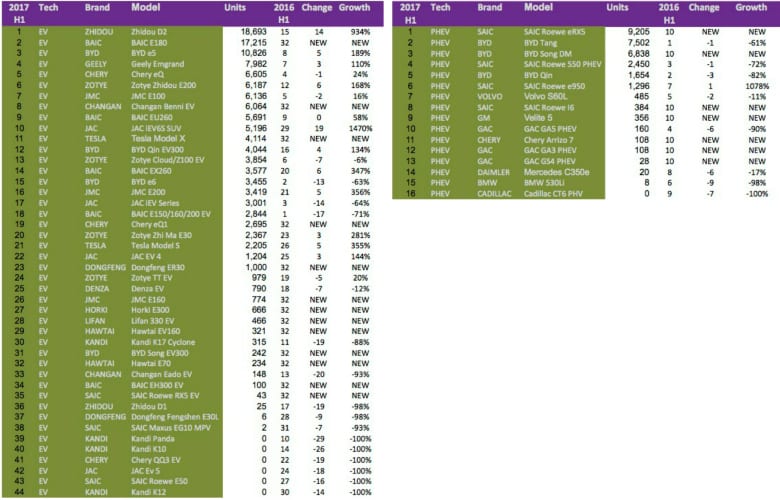
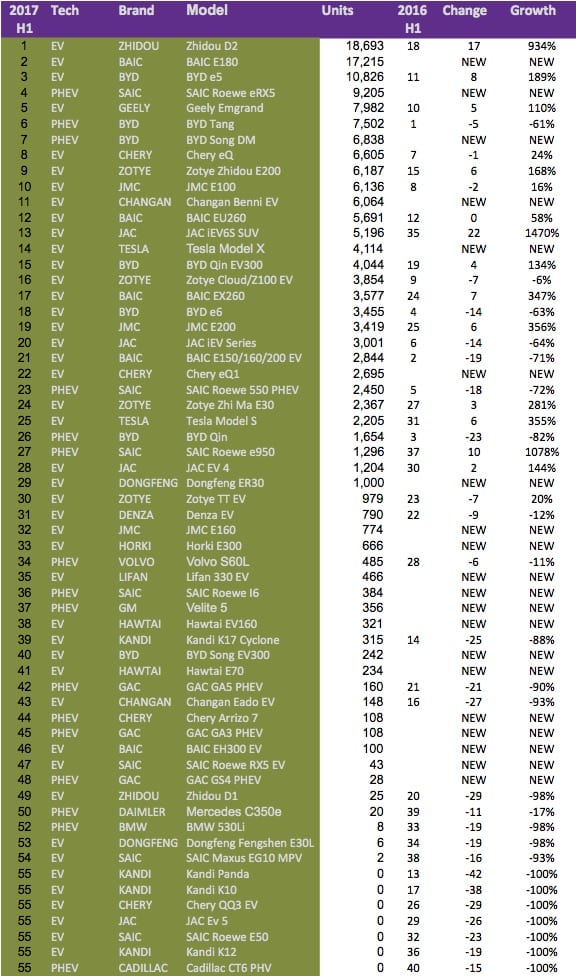
Be sure to check out our new presentation of all EVs since 2010 to gain great insights on all auto brands and their electric vehicle strategies. We have also created presentations per technology type BEV, PHEV, and FCEV.
The page you requested could not be found. Try refining your search, or use the navigation above to locate the post.
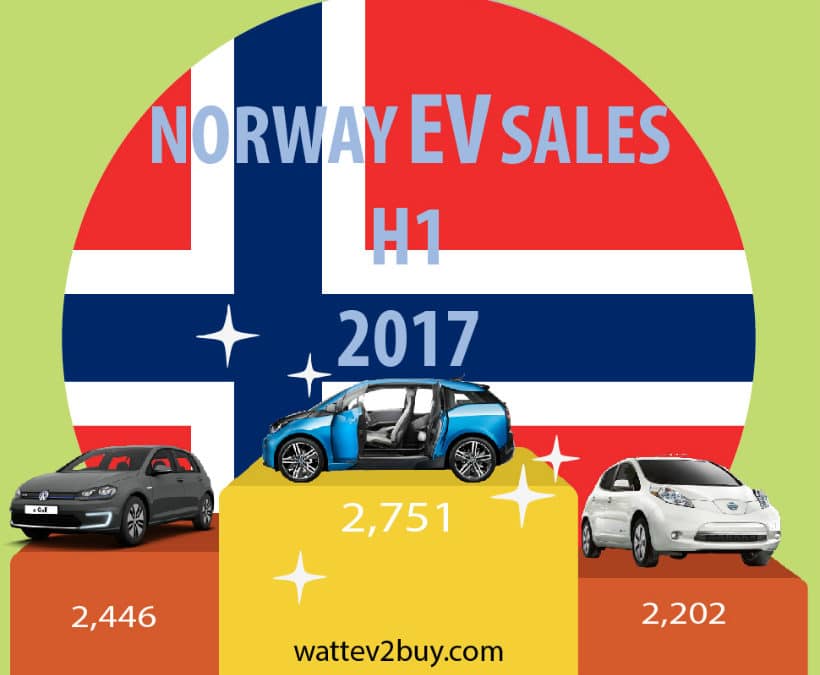
We look at the Top brands, Best and Worst Models and how the battle between battery electric (BEV) and plug-in hybrid (PHEV) technologies play out in the summary of EV Sales in Norway H1 2017.
The highlights for Norwegian electric car sales in H1 2017 was:
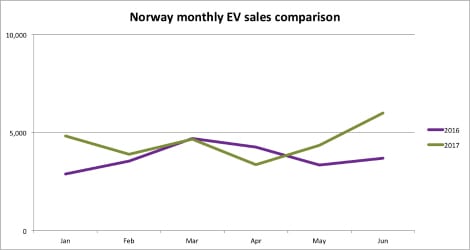
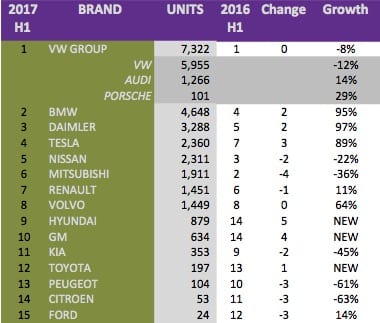 We saw very big changes in the Top 3 electric vehicle brands in Norway with only VW Group retaining its Top position, albeit with lower sales in its mass-market VW brand. Japanese automakers, Mitsubishi and Nissan were pushed from the Top 3 by German luxury automakers BMW and Daimler. Tesla sales also surpassed that of Mitsubishi and Nissan, with a strong performance by the Tesla Model X more than offsetting the slide in Tesla Model S sales. Tesla now commands over 11% of the total EV market in Norway.
We saw very big changes in the Top 3 electric vehicle brands in Norway with only VW Group retaining its Top position, albeit with lower sales in its mass-market VW brand. Japanese automakers, Mitsubishi and Nissan were pushed from the Top 3 by German luxury automakers BMW and Daimler. Tesla sales also surpassed that of Mitsubishi and Nissan, with a strong performance by the Tesla Model X more than offsetting the slide in Tesla Model S sales. Tesla now commands over 11% of the total EV market in Norway.
French automakers Renault, Peugeot and Citroën gave up positions to their peers as Hyundai and GM entered the market with the new Ioniq and Opel Ampera-e (Bolt EV) mass-market EVs. It is disappointing that first movers such as the PSA Group grew too comfortable supplying the same models for the past 5 years without preparing a response to longer range mass-market vehicles. Toyota has not achieved the same stellar sales in Norway with the new Toyota Prius as it did in some of its other markets.
The Top 10 gainers in sales growth over 2016 were mostly plug-in hybrid vehicles (PHEV) while the top selling vehicles by units were mostly battery electric vehicles (BEV). The BMW i3 rose a healthy eight positions and ate into the sales of the VW e-Golf, VW e-Up, VW Golf GTE, Audi A3 e-tron, and Nissan Leaf. Norway is now the second best market, after the USA, for the German manufactured BMW i3 accounting for 8% of all electric vehicles on the country’s roads. The Tesla Model X performed very well, helping Tesla to nearly double its sales in Norway. The rise of the Model X, now the best performing luxury EV in Norway, came at the expense of the BMW X5 xDrive and Mitsubishi Outlander. Luxury brands Daimler and BMW‘s large selection of PHEV models performed well in Norway with the Mercedes GLC350e helping Daimler to be the leader in the luxury class over BMW. It is only Daimler’s lack of an answer to the BMW i3 that kept the automaker in the third spot overall.
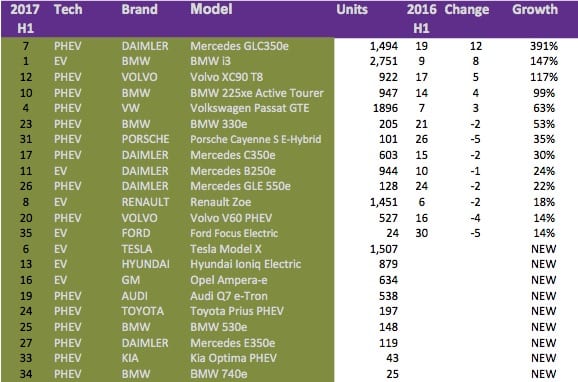
The VW brand sold 1,540 units less than last year across the VW Golf GTE, VW e-Golf, and VW e-Up models. The VW Group lost nearly 2,000 units in total if one should factor in the sales loss from the Audi A3 e-tron. The biggest overall loser was the Mitsubishi Outlander PHEV which sold 1,040 units less than the same period in 2016. The Tesla Model S is following the same trend as we see in many other countries, losing 31% or selling 388 units less than last year.
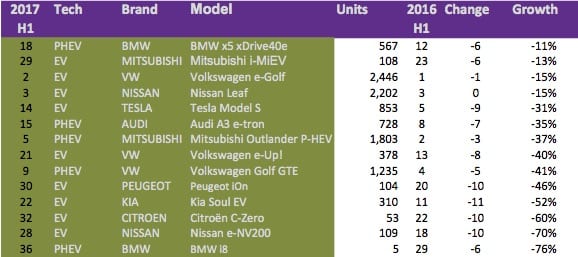
Pure electric vehicles (BEVs) extended their lead over plug-in hybrid vehicles (PHEV) to 20.6% from 17.3% in H1 2016 despite having fewer models to offer. A total of 14,753 BEVs sold in the first-half of 2017 in Norway compared to 12,231 PHEVs. For our calculation, we included the BMW i3 REx as a BEV since we don’t have an accurate breakdown of BMW i3 sales between the BEV and range extended version.
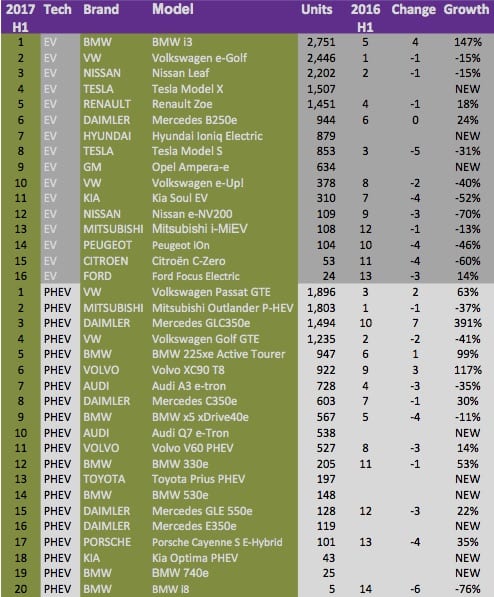
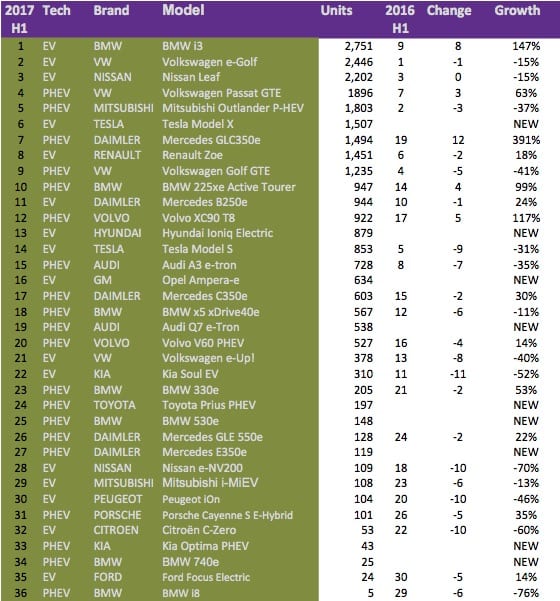
Be sure to check out our new presentation of all EVs since 2010 to gain great insights on all auto brands and their electric vehicle strategies. We have also created presentations per technology type BEV, PHEV, and FCEV.
The page you requested could not be found. Try refining your search, or use the navigation above to locate the post.
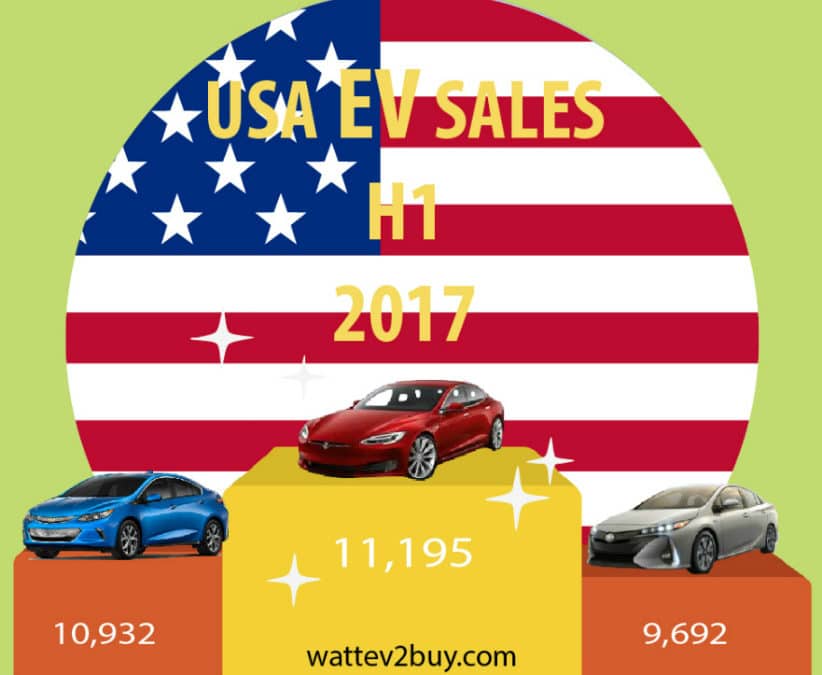
We look at the Top brands, Best and Worst Models and how the battle between battery electric (BEV) and plug-in hybrid (PHEV) technologies play out in the summary of USA EV Sales H1 2017.
The highlights for USA electric car sales in H1 2017 was:
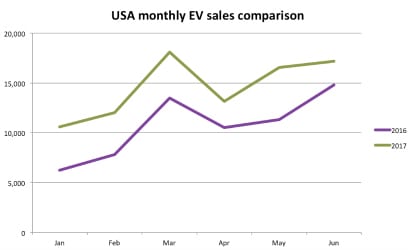
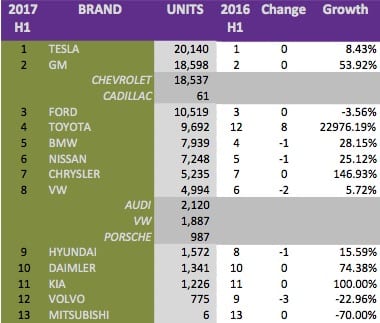
There are no surprises in the Top 3 EV brands with Tesla holding on to its lead over GM due to a 24% rise in Tesla Model X sales. GM could not dethrone Tesla even with a new model, the mass-market Chevrolet Bolt EV up its sleeve. Improved sales in the 2nd Quarter from the Ford Fusion Energi and C-Max Energi helped the brand retain its third position fighting off the strong performance of Toyota with the new Toyota Prius which was placed third at the end of the first quarter.
Most brands showed improved sales growth over the first half of the year with only Ford, Volvo, and Mitsubishi showing declining sales. The Volkswagen Group showed a declining trend as the year progressed and mustered the lowest growth. The declining fortunes of the German automaker can be attributed to the Volkswagen e-Golf not being able to compete on range with the new mass-market Chevrolet Bolt being sold in the same price bracket. Chrysler showed the highest growth after Toyota buoyed by the new Chrysler Pacifica and great specials on its compliance car, the Fiat 500e. The results might have been better for the US automaker, but the Chrysler Pacifica launch was delayed and then impacted by recalls and plant closure due to battery problems.
Most of the existing models showed growth lower than the overall growth due to the big number of new models to the market. Surprisingly the Ford Focus and Fiat pure electric models outperformed the market showing that the public is becoming more comfortable with range issues and the continuously improving charging infrastructure is starting to have and effect on top of the financial incentives making EVs appealing.
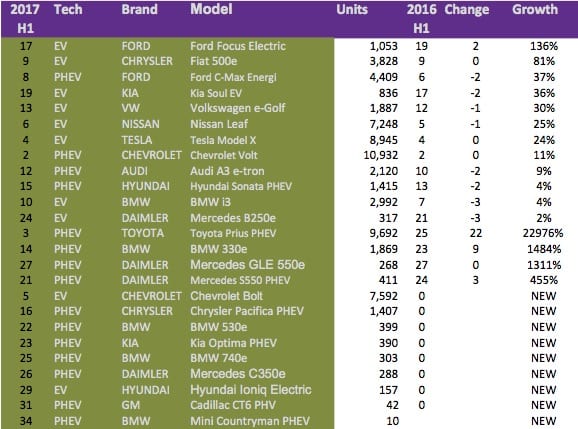
European plug-in vehicles were the biggest losers in this half of 2017 with a number of the luxury PHEV models losing big. Volvo and BMW saw some of their relatively new models losing steam. Both the BMW x5 xDrive and Volvo XC90 T8, released in 2016, lost market share in favor of the Tesla Model X. The Tesla Model S sales have flatlined although it remained the top selling BEV model. It will be interesting to see how the new Daimler Smart ForTwo ED fares in the second half of 2017. The German automaker is relaunching the brand as electric only in the USA and Canada from this summer and will offer a slightly improved model at a marginally reduced $23,800 starting price before incentives.
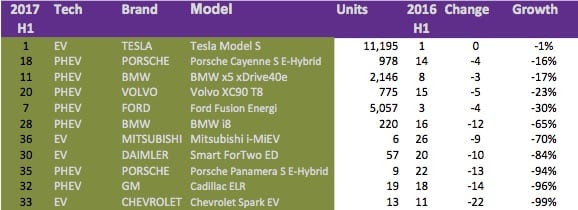
Battery electric vehicles are still maintaining its lead over plug-in hybrids albeit at a lower margin. BEVs took six positions in the Top 10 EV sales for the USA in the first half of 2017. The ever increasing number of plug-in models benefits the technology in the short term as it competes with only a handful of pure electric models. The Plug-in hybrid category benefited mostly from the release of the new Toyota Prius and to a lesser extend the Chrysler Pacifica. The Tesla Models X and S constitute nearly 44% of all BEV models showing the company’s dominance in the sector. The commanding position will improve even more with the release of the Model 3 in the second half of 2017 which might add about 40,000 units depending on the production ramp-up. The release of the Tesla Model 3 and new Nissan Leaf, expected by the end of the year, should help pure electric vehicles outperform the more dirty plug-in hybrids in the second half.
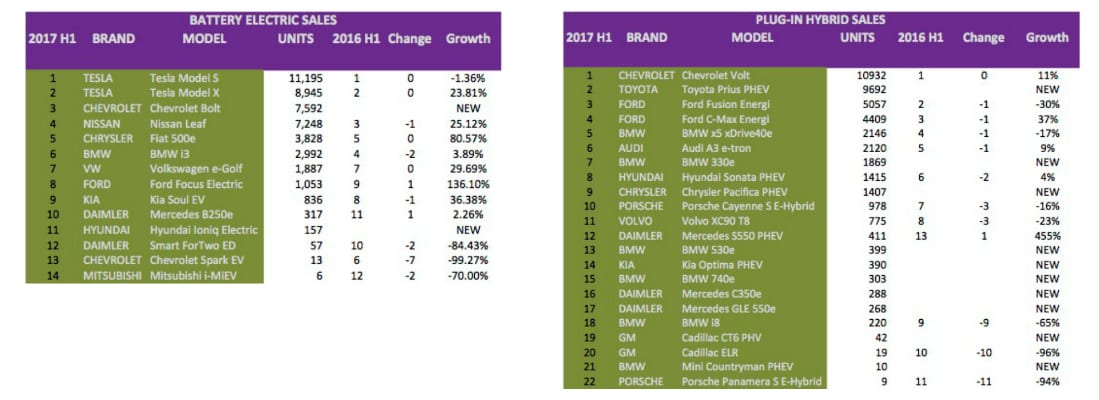
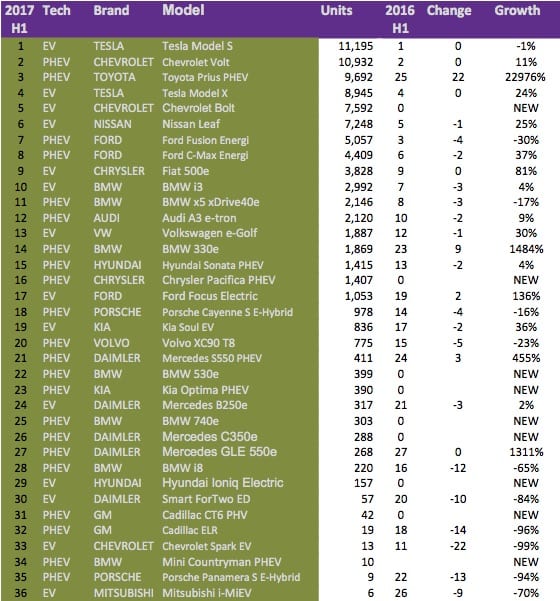
Be sure to check out our new presentation of all EVs since 2010 to gain great insights on all auto brands and their electric vehicle strategies. We have also created presentations per technology type BEV, PHEV, and FCEV.
The page you requested could not be found. Try refining your search, or use the navigation above to locate the post.

Now that all the Q1 data is in we can do a detailed dissection of the hottest quarter in EV history in which nearly 200,000 electric vehicles was sold. The headline data is that nearly 180,000 EVs were sold in the top 10 EV countries. Battery Electric Vehicles (BEV)  outperformed Plug-in Hybrid Vehicles (PHEV) by a long shot. A total of just over 106,000 BEVs were sold while only around 70,000 PHEVs moved off the dealership floor in the top 10 countries.
outperformed Plug-in Hybrid Vehicles (PHEV) by a long shot. A total of just over 106,000 BEVs were sold while only around 70,000 PHEVs moved off the dealership floor in the top 10 countries.
One of the standout data points is USA EV sales which overtook China as the best market for electric vehicles in Q1, making the USA the top EV country in Q1. The worst performer was The Netherlands, who fell out of the top 10. The Netherlands disappointing performance over the last couple of quarters does not bode well for the European country was seen, next to Norway, as one of the proponents of the technology. Only last year still did the Dutch Government contemplated a goal to be 100% electric by the middle of the next decade. It is unclear what caused the drop in EV sales in the Netherlands.
When comparing this quarter’s EV sales by country to their respective totals for 2016 one can see that the pace of EV sales picked up in most. If one should expect that by the end of Q1 EV sales should equate to roughly 25% of 2016, it is only China and The Netherlands that are underperforming. Chinese EV sales have lagged in January due to technical factors including a clampdown on EV subsidy fraud and the annual Chinese holiday, in which most industries shut down. Chinese EV sales have picked up the pace in the following months and the quarter still ended up 30% over the same period of the previous year. It can be concluded that EV sales for the first quarter in China are historically weak and Q1 2017’s performance is by now way an indication of a trend. Furthermore, the Chinese Government last week announced a plan to dominate the electric vehicle sector which should help the country to regain its stature. Japan, on the other hand, has picked up the strongest pace and has already achieved EV sales equal to 59% of its total 2016 sales. The Japanese EV market has the least variety of EV models available to consumers, and it is anticipated that the introduction of more models will stimulate the market further. Germany is the second best performer helped by a 77% improvement in EV sales on a year-to-year basis.
The top EV brand in the Top 10 EV Countries is Tesla for the second year running. Tesla announced in its April trading update that it sold just over 25,000 Models S and X globally. It is important to note that the figure repo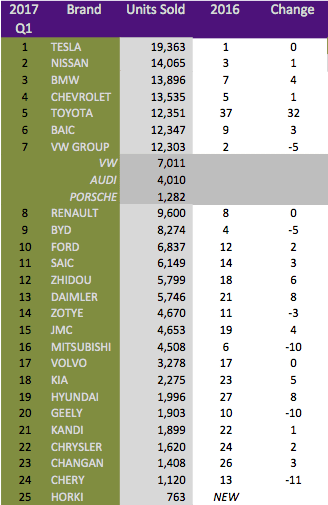 rted includes vehicles being shipped, while country sales data shows vehicles registered. Toyota is back in the Top 10 list of EV brands on the back of a well-received new Toyota Prius. Chevrolet did not shoot the lights out with its new mass-market EV, the Chevrolet Bolt / Opel Ampera-e. Most of GM’s sales came from the Chevrolet Volt PHEV. The company is criticized for producing a limited amount of the Bolt and is being labeled as a compliance company for that, a term used for auto manufacturers that only sell EVs in Zero Emission states to gain credits. The big losers included VW, BYD, and Mitsubishi. BYD has been the Top EV manufacturer for 2015 and 2016 globally and was at the number three position for most EVs sold since the start of the decade. Competition from the likes of BAIC and SAIC is the main reason for the companies bad performance. Up til 2016, BYD had the advantage of being first to market, but some new models that can compete on performance and quality with BYD entered the market since 2016. (This sentence could very well be used for Tesla in a couple of years). Mitsubishi fell a staggering ten places as the company has not updated its popular Outlander PHEV or introduced new models as a replacement.
rted includes vehicles being shipped, while country sales data shows vehicles registered. Toyota is back in the Top 10 list of EV brands on the back of a well-received new Toyota Prius. Chevrolet did not shoot the lights out with its new mass-market EV, the Chevrolet Bolt / Opel Ampera-e. Most of GM’s sales came from the Chevrolet Volt PHEV. The company is criticized for producing a limited amount of the Bolt and is being labeled as a compliance company for that, a term used for auto manufacturers that only sell EVs in Zero Emission states to gain credits. The big losers included VW, BYD, and Mitsubishi. BYD has been the Top EV manufacturer for 2015 and 2016 globally and was at the number three position for most EVs sold since the start of the decade. Competition from the likes of BAIC and SAIC is the main reason for the companies bad performance. Up til 2016, BYD had the advantage of being first to market, but some new models that can compete on performance and quality with BYD entered the market since 2016. (This sentence could very well be used for Tesla in a couple of years). Mitsubishi fell a staggering ten places as the company has not updated its popular Outlander PHEV or introduced new models as a replacement.
The Top 10 EV models are still lead by the Nissan Leaf, a phenomenal performance by the 7-year-old EV. The Toyota Prius replaced the Tesla Model S in the top two while the Tesla Model X performed the best of the 2016 Top 10 cohort. Newcomers Chevrolet Bolt, BAIC E-180, and the Toyota Prius replaced the BYD e6, BYD Tang and Mitsubishi Outlander in the Top 10 EV models list for Q1.
Please use the comment section below to share your thoughts on the EV market.
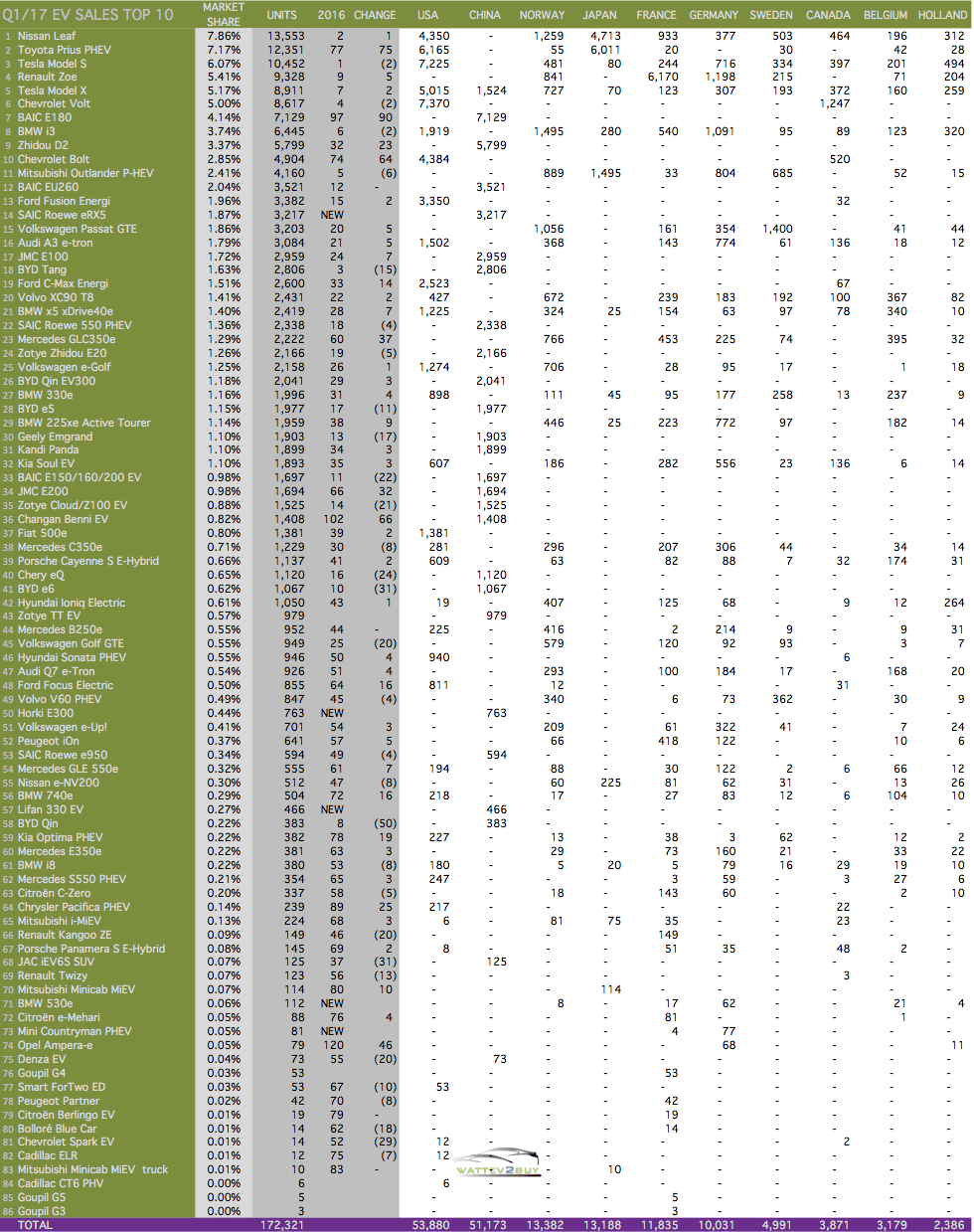
Note on data: The detailed data above does not include the UK, who keeps their EV data more secret than Donald Trump does classified information.
The page you requested could not be found. Try refining your search, or use the navigation above to locate the post.
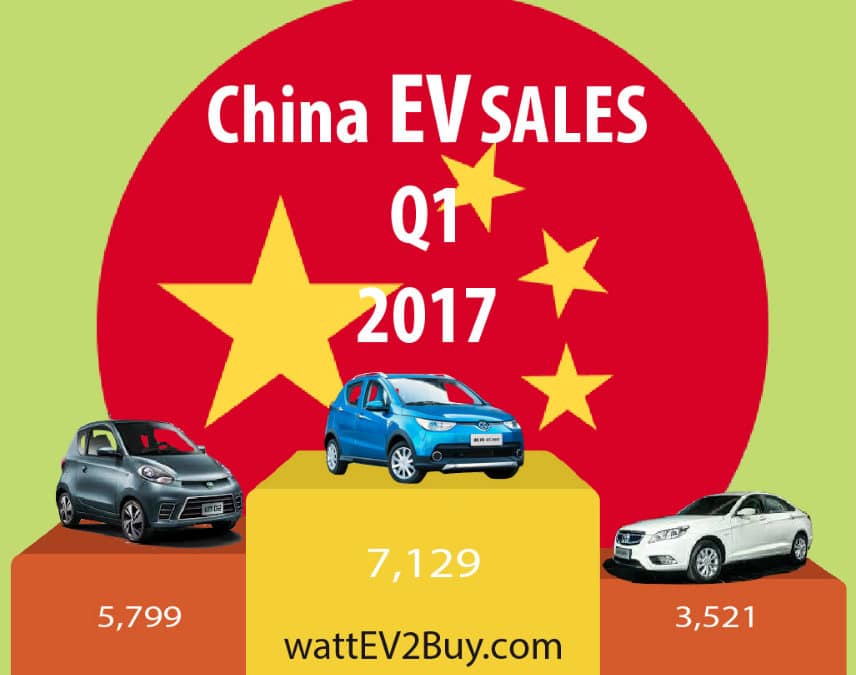
China, the world’s largest market for electric vehicles showed a rise in sales for the first quarter of 2017, improving on 2016 figures by 12,500 units. While March was a particularly good month, selling over 30,000 units, we wonder if the total sales of nearly 56,000 units in the first quarter will be enough for 2017 to beat the record of 350,000 set in 2016?
EV sales for 2017 kicked off rather poorly in January with a disappointingly low 7,000 units. The Chinese holiday season and the regulatory clampdown on the abuse of EV subsidies were blamed for the lackluster sales. Fortunately, sales improved as the following months saw a doubling each month on the previous, setting a very promising trend. Battery Electric Vehicles outsold Plug-In Hybrids by nearly five to one as over 44,000 BEV units were sold compared to only 9,000 PHEV models during the period.
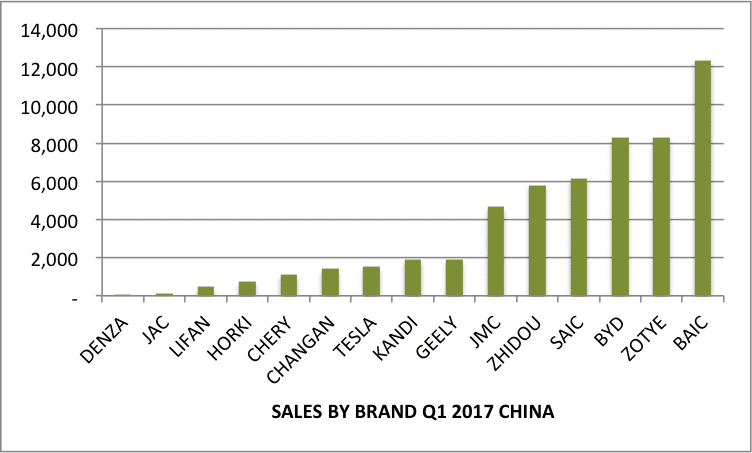
New models were the top sellers, taking three of the top five positions in a country starved for cool looking EVs. Chinese consumers are used to being dished up a mix of inferior cars due to major international brands being forced to partner with local manufacturers. To protect their IP, the global brands produced older variants of their vehicles for the Chinese market. The situation has improved for the Chinese consumer as local producers such as BAIC, SAIC and BYD have started producing improved second generation EV models. The BAIC E180 and BAIC E260, taking the first and third positions for the quarter is a case in point of how the second generation electric vehicles are drawing more buyers to the sector.
2016’s darling, BYD is slipping in the rankings, the company, part-owned by Warren Buffet, which has been the best-selling electric vehicle brand in the world for 2015 and 2016 could only muster two-thirds of BAICs sales. More worrying for BYD is that it had five models in the market compared to BAICs three BEVs. Tesla had a respectable performance with the Model X selling 1,500 units, which is 13% of all Tesla Model X units sold internationally during Q1, accounting for 6% of the company’s total sales for the period.
In total Q1 2017 sales improved 30% on that of the same period in 2016, indicating that 2017 could even be a better year for electric vehicles, despite stricter regulation, proving that electric vehicles are entering the mainstream.
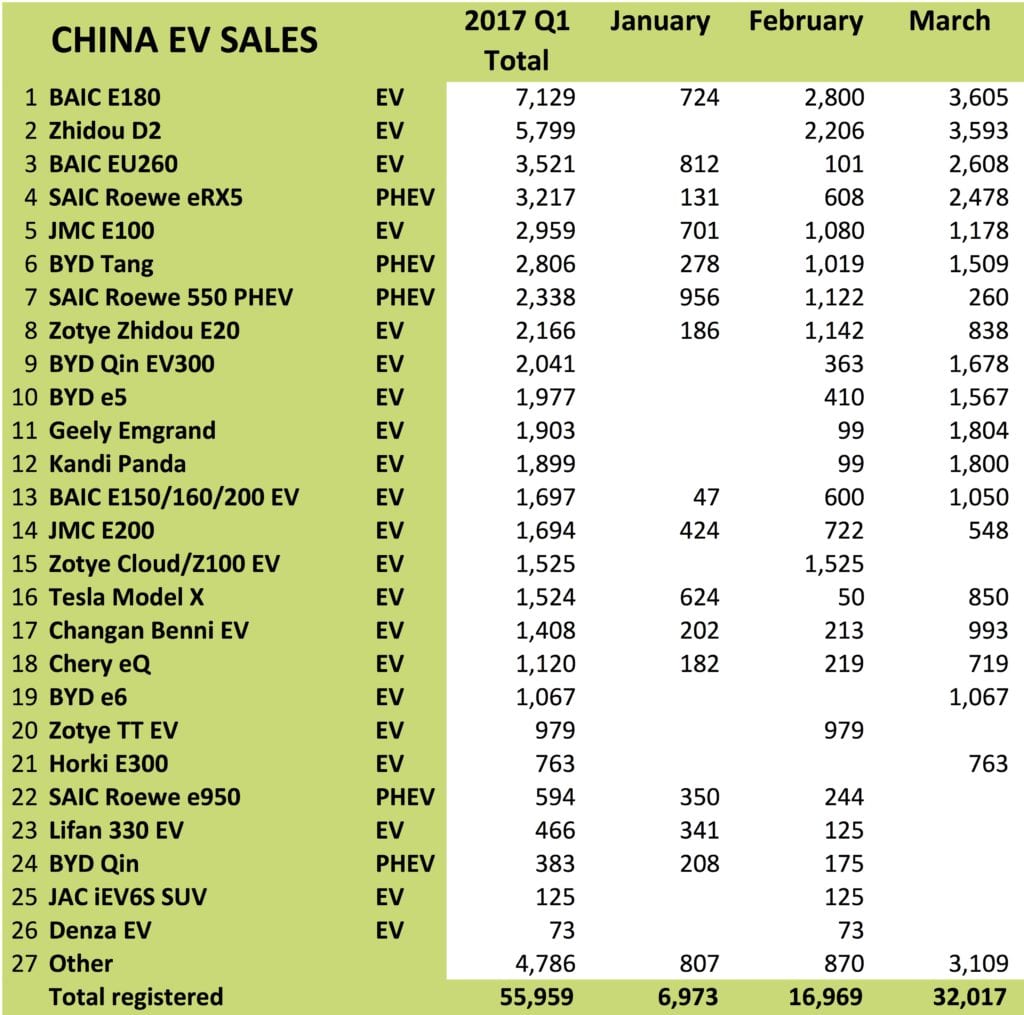

UK EV sales for the first quarter 2017 set new records, mostly on the back of Tesla sales. The quarter’s sales bring EV’s contribution up to 1.4% of the total vehicle fleet. The UK sales for Q1, traditionally the best performing quarter for UK car sales, was closely watched as a new Vehicle Excise Duty (VED) comes into play from the first of April 2017. The new VED rules apply for all vehicles except zero emission vehicles (ZEV). According to the VED, Internal Combustion Engine vehicles (ICE) will be liable for a levy of £1,550 spread over five years on all vehicles priced over £40,000.
Electric vehicle sales for March, which contributed nearly 70% of the quarter’s sales, rose a below average 7% on a year-to-year basis, lower than the 8.4% for the total new car market. Total EV sales for the quarter was around 11,900 units, some 880 units more than Q1 2016. A deeper analysis of the UK electric vehicle sales showed a significant rise of the Battery Electric Vehicle (BEV) component, rising 34%, or around 800 units in March from the year before. Most of the 800 units can be attributed to Tesla’s massive sales drive, which led to a record 25,000 units being sold internationally, of which nearly 900, triple February’s sales, was sold in the UK during March 2017.
The improved performance of BEV vehicles compared to Plug-In Hybrid Electric Vehicles (PHEV), showing a decrease of 5% to just under 5,000 units, corrects a trend since 2016 which saw 3-in-4 electric vehicles in the UK being PHEV’s.
All indications are that UK EV sales will breach the 100,000 unit mark, shared by only seven other countries within the next couple of months. Recent surveys in the UK showed that most vehicle buyers are negative towards diesel vehicles due to diesel gate, a spectacular own goal by big auto and that 85% of vehicle owners now consider buying an EV, subject to them overcoming these EV related misconceptions.

The article was first posted in wattEV2Buy’s Top 5 EV News Week 14.
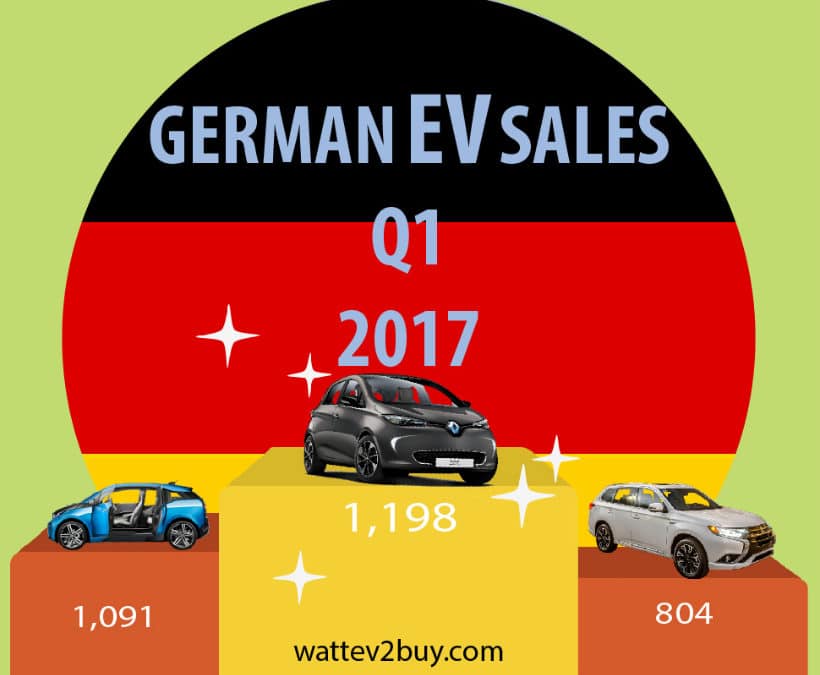
EV sales in Germany nearly doubled to around 10,100 units from a year ago when only 5,700 electric vehicles were sold. Battery Electric Vehicles (BEV) outsold Plug-in Hybrid Electric Vehicles (PHEV) by 10% on the back of strong sales of the new Renault Zoe Z.E. 40. The New Zoe has an NEDC range of 248mi / 400km, which is more likely an EPA (real world) range of 190mi / 300km.
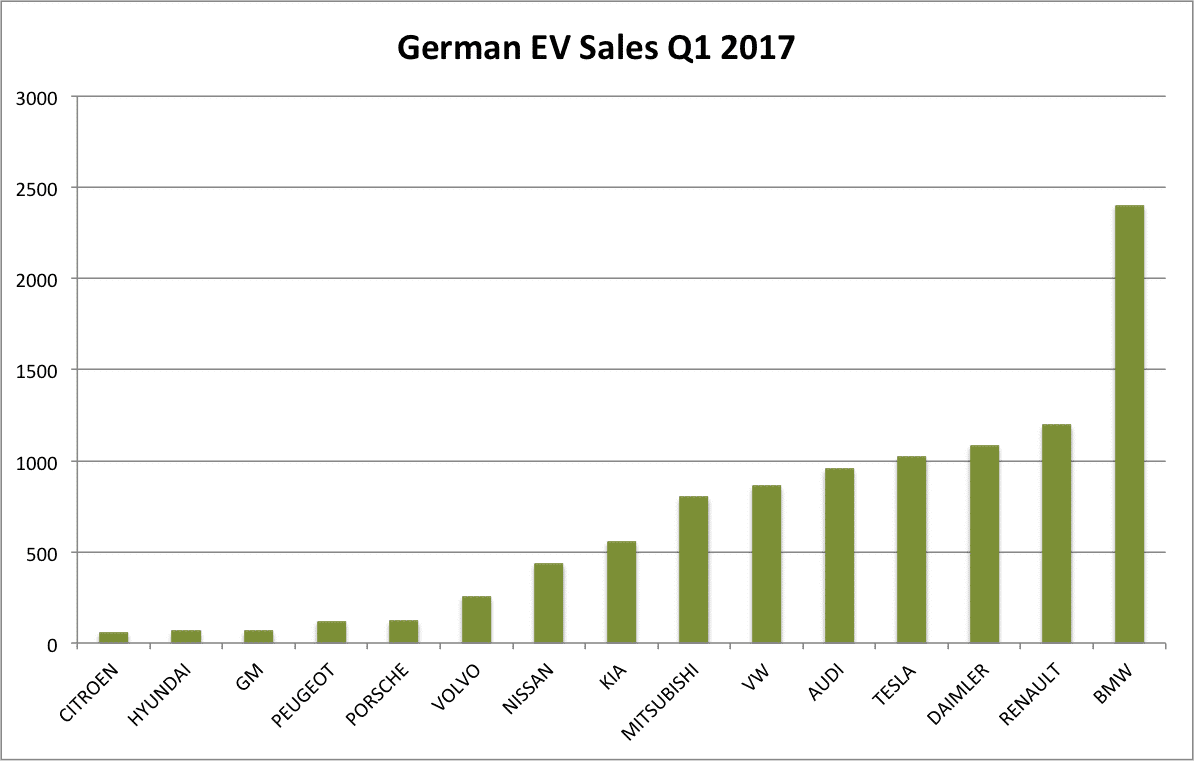
The worst-performing models were the VW Golf GTE, selling over 80% less than a year ago, the VW e-Golf, selling 43% less and the BMW X5 XDrive40e losing 33% of its sales. The Nissan Leaf also underperformed, partly due to the New Renault ZOE and partly due to a new version being expected later the year.
The BMW i3 took the second position with nearly 1100 units sold, of which 62% were the BEV version, an opposite scenario as for the same period last year when 68% of all BMW i3s sold were the range extending version.
New models for the quarter includes the Opel Ampera-e (Chevy Bolt), Hyundai Ioniq Electric, Mini Countryman, BMW 530e, BMW 740e, Tesla Model X, Mercedes-Benz GLC350e and E350e. The best performers from the newcomers were the Tesla Model X, a BEV and Mercedes-Benz GLC350e, a PHEV. The worst performers were the two new BEVs, the Opel Ampera-e and Hyundai Ionic, both selling only 68 units each. The BMW 530e was the worst performing new PHEV, with only 62 units sold.
The worst performing brands were VW, Porsche, and Nissan, which incidentally were the only brands losing market share in this record breaking quarter. Of further significance is that both Porsche and VW are indigenous to Germany. Even including Audi’s sales data to that of VW and Porsche still puts the VW Group at the bottom of the list with a mediocre 2.2% growth year-on-year.
All-in-all the Q1 2017 sales data points to a record-breaking year for the German EV market, which could help it ascend from its 9th position on the list of Global EV sales by country, should UK EV sales flounder.
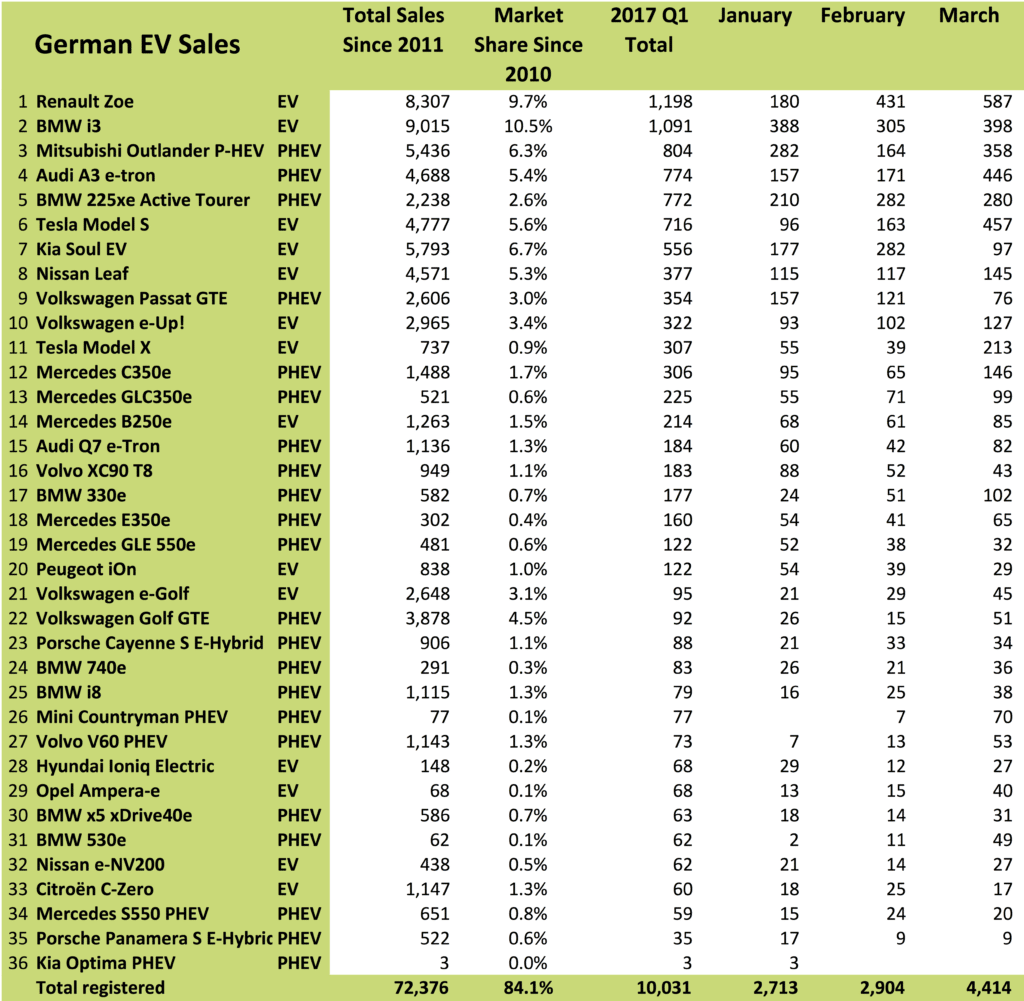
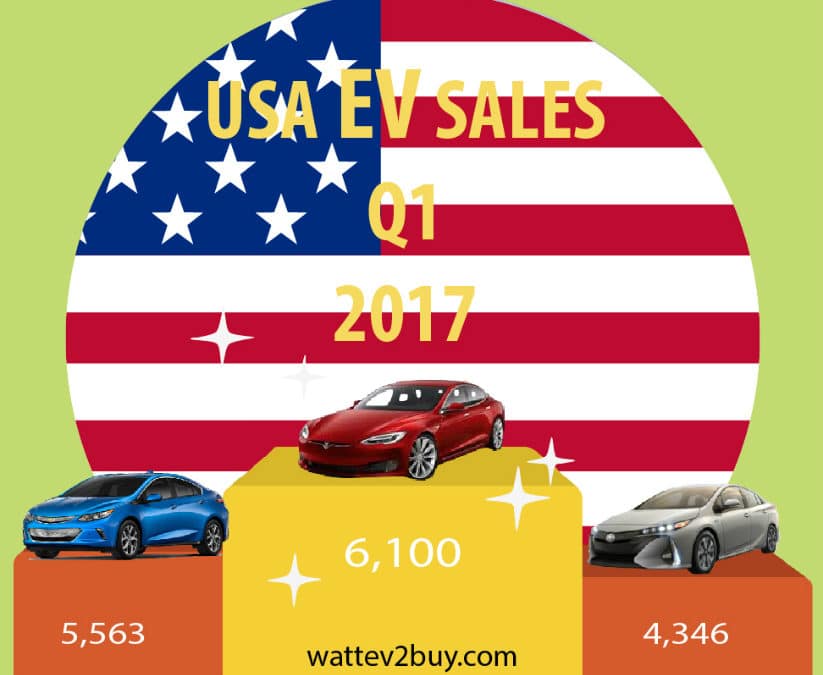
We look at the Top brands, Best and Worst Models and how the battle between battery electric (BEV) and plug-in hybrid (PHEV) technologies play out in the summary of USA EV Sales Q1 2017.
The highlights for USA electric car sales in Q1 2017 was:
There are no surprises in the Top 3 Electric Vehicle Brands as Tesla remained on top, due to increase sales of the Tesla Model X, and GM and Toyota brought new models to book. Quarter 1 2017 was the first full quarter for the Chevrolet Bolt, the world’s first mass-market car. The Chevrolet Bolt‘s performance was rather disappointing, with sales dropping from a January high. The reason can be one of two, either GM‘s slow roll-out is to blame, or most buyers are waiting for the Tesla Model 3. Toyota’s only Plug-In Hybrid (PHEV) vehicle, the Toyota Prius Premium, performed remarkably well, taking in consideration that the battery capacity and range does not offer a real advantage to its competitors.
The bad boy on the block was Ford, barely hanging on to the Top 5 list of electric cars. Were it not for Porsche’s bad performance in the VW Group; the German automaker would have unseated Ford in the Top 5. BMW dropped out of the Top 5 list as Toyota entered the list in the third position. Daimler showed commendable improvement while Hyundai and Volvo joined Ford on the losing side. Nissan still shows consistent growth with its only electric vehicle, the Nissan Leaf.
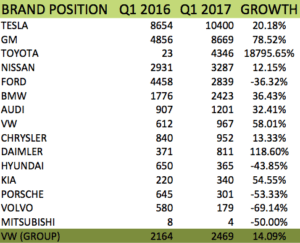
Of the new electric vehicle models that came to market in this quarter, the Toyota Prius Premium, a PHEV outperformed GM‘s Chevrolet Bolt, a BEV by nearly 30%, a disappointing performance for the first mass-market electric vehicle. Both Mercedes-Benz and BMW had two more models in this quarter compared to 2016, with the Mercedes-Benz C350e and Mercedes-Benz GLE 550e outselling the BMW 330e and BMW 740e.
The Mercedes Benz S550 PHEV, BMW i3 2017 and Tesla Model X were the best performing existing models, although for the BMW i3, its the 50% improvement in battery capacity that attributed to its increase in sales.
The Tesla Model S sales remained flat on a year-to-year basis, despite continued improvements in its software and hardware.
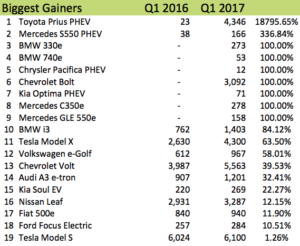
Sales of the Cadillac ELR fizzled out completely in anticipation of the release of the Cadillac CT6 PHEV this month. Both the Porsche Cayenne and Panamera showed big losses in sales from a year ago, impacting on total growth for the VW Group. Judging from the Ford models sales slump, it is clear the century-old automaker needs to reassess it electric vehicle strategy. The big drop in the Volvo XC90 T8 can be attributed to the challenge faced by all automakers coming late to the electric vehicle party. To enter the electric vehicle market, lagging brands alter existing models to include batteries but in the process lose performance as drivers complain about smaller fuel tanks.
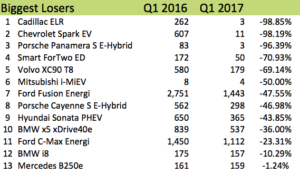
Battery Electric Vehicle’s (BEV), of which nearly half is constituted by the two Tesla models, outperformed plug-in hybrid electric vehicles. Over 20,000 BEV units were sold in the first quarter of 2017 compared to just under 15,000 a year ago. Q1 2017’s 19.2% increase in sales showed a slight improvement for the technology on Q1 2016 when BEV outsold PHEV with 17%. The USA is one of the few countries where BEV vehicles outsold PHEV’s since 2016, read our blog on the Top 10 EV Markets.
In total there is 13 BEV models and 20 PHEV models available in the USA market in 2017 so far. Consumers had a choice of seven new PHEV models in Q1 2017 and one BEV compared to the same period in 2016.
New model’s coming to market in the next quarter include three plug-in hybrids, the Cadillac CT6 PHEV, BMW 530e, and the Porsche Panamera 4 E-H, while only one BEV, the Hyundai IONIQ Electric will be released, should there be no surprises from Tesla on the Model 3.
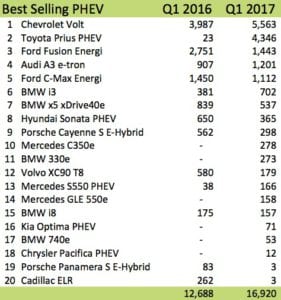
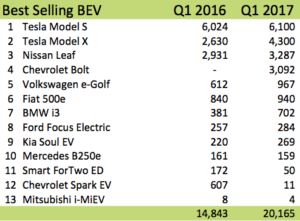
Please leave us a comment on your thoughts regarding the electric vehicle models available to the US consumer.
Note on data used: For comparison purposes, the BMW i3 sales data was assumed to be divided in two, to accommodate for the BMW i3 BEV and REx PHEV
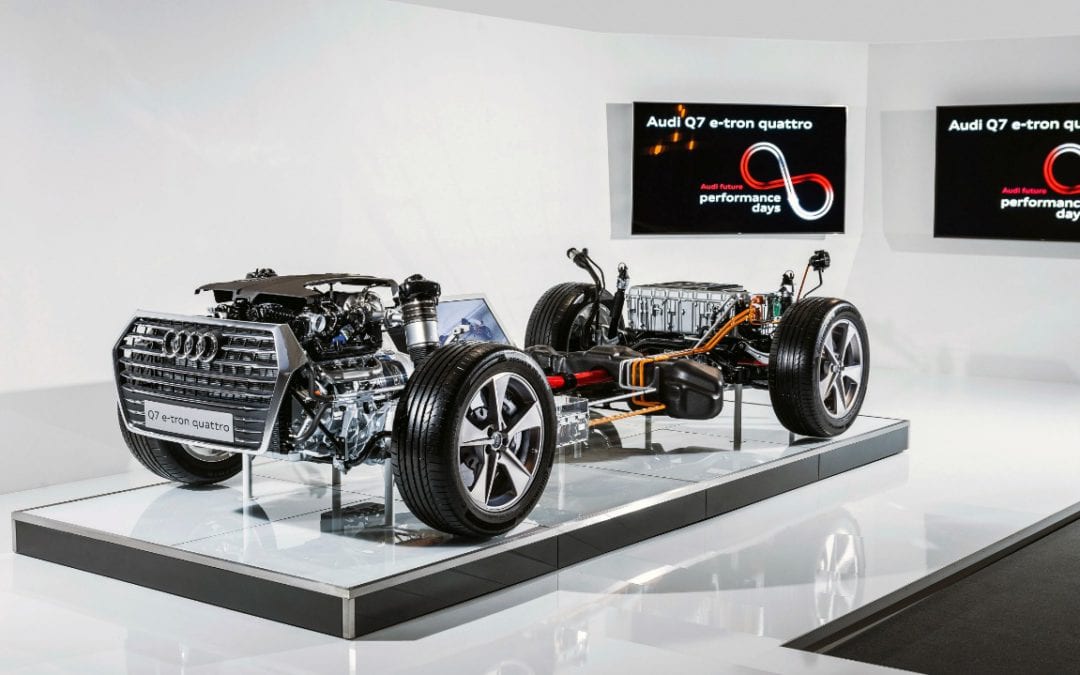
Battery Electric Vehicles (BEV), also known as pure electric vehicles, has outsold plug-in hybrid electric vehicles since the start of the decade. Intuitively one would have thought that because of the high cost of battery cells at the onset of electric vehicles that Plug-in Hybrid Electric Vehicles (PHEV’s), such as the Toyota Prius, would have been the best first step to enter the market, which the company initially did until it abandoned the technology. Traditional auto manufacturers (Big Auto) in general did not take electric vehicles seriously, leaving the task to start-ups such as Tesla to develop solutions for the consumer. In the auto industry, it is easier for new entrants to enter with new technology than compete with Big Auto, churning out engines from plants which cost has already been recovered. Thus leaving Big Auto at a disadvantage as they have to invest in research and infrastructure, playing catch up with the disruption.

The big driver’s behind the performance of BEV’s has been:
It is expected that the trend for BEV’s should remain favorable as technology and cost improvements and more automakers plan to bring BEVs to market by the end of the decade. Analyzing the Top 10 EV markets, which represent over 90% of all EVs sold, however, show the opposite. Surprisingly, at closer inspection, PHEV’s are gaining on BEV’s in the majority of the Top 10 EV markets. In our study below we compare the proportion of BEV’s to PHEV’s in the Top 10 EV markets by plotting all EV’s sold from the start of the decade to EV’s sold since 2016, when most automakers changed their electric vehicle strategies. (For more detail follow the links to the different countries for a complete breakdown of sales per model and year in that country).

Chinese BEV’s, not always the most beautiful looking cars, have performed very well since the start of the decade and even more so over our test period from 2016. There are only three PHEV’s of any value worth mentioning in China, namely the BYD Qin, BYD Tang and SAIC Roewe 550, which combined sales accounted for around 18% of all EV’s sold since the turn of the decade. 2016 for the first time saw larger sedans taking over from the micro BEV’s, with the BYD e6, BAIC EU260, and Geely Emgrand entering the Top 4 list in the country. It is clear that with aggressive government support sales for BEV’s are ever increasing in the world’s Top market for EVs.

The home of Tesla and compliance vehicles, the USA, is the second largest market for electric vehicles. Stripping out Tesla, which accounts for nearly 40% of all BEV’s sold in the country will provide a completely different picture than above, where the BEV and PHEV ratio mirrors a presidential race. Most Big Auto brands are represented in the country, and when we say country, we can be forgiven to say California, where it’s Air Resource Board developed the Zero Emission Vehicle Program, targeting 15% of all vehicles to be ZEV’s by 2025. The ZEV Program supports the adoption of BEV’s by forcing automakers to sell a certain percentage of Zero Emission Vehicles. The ZEV program has been adopted by nine other states, which in total account for around 30% of all new vehicle registrations in the USA. The result is that even automakers with no EV strategy, including Fiat Chrysler, are selling what is called “compliance vehicles,” being converted plug-in variants of existing models, such as the Fiat 500e and Chrysler Pacifica. GM has also been labeled a compliance company by some, even though it introduced the first mass-market EV, the Chevrolet Bolt. The argument against GM is that it only released the Bolt it the ZEV States while it produces an uninspiring amount of 30,000 vehicles. On the other hand, GM is supporting the fight against clean air regulations and Tesla‘s direct sales model, effectively trying to halt the progress in the EV sector.

Japan, the fourth largest of the Top 10 EV markets, with China, is one of the few countries in the Top 10 list where BEV’s are outselling PHEV’s. In the case of Japan BEV’s contributed to around 75% of all EV’s sold. The country is however not the best example of expanding BEV sales. Only three brands contribute to over 90% of the sales through four models, namely the Nissan Leaf (EV), Mitsubishi Outlander (PHEV), Mitsubishi i-Miev (EV), and Toyota Prius (PHEV), which production was halted in 2015 for re-release in 2017. No great analytical deduction can be made other than a 40% increase in Nissan Leaf sales and 50% drop in Mitsubishi Outlander sales in 2016 resulted in the shift in favor of BEV’s.
 The Netherlands is a big hope for the EV sector. The country targets an 100% electric fleet by 2025. However, the data don’t really show encouragement for zero emission vehicles in a country one would have guessed would be ideal for BEV’s due to the relatively short distances within its borders ( sorry if this does not sound very Euro-centric). BEV sales have stagnated since 2013 with the Nissan Leaf and Tesla making up most of the market. The EV’s sector is dominated by PHEV’s from Volkswagen, Audi (also VW), Volvo, BMW, and Mitsubishi. The Mitsubishi Outlander PHEV is a big hit, cornering nearly 25% of the EV market in the Netherlands. The country also has the highest international sales of the Mercedes C350e, Volkswagen Passat GTE, Volvo XC90 T8 and V60 PHEV.
The Netherlands is a big hope for the EV sector. The country targets an 100% electric fleet by 2025. However, the data don’t really show encouragement for zero emission vehicles in a country one would have guessed would be ideal for BEV’s due to the relatively short distances within its borders ( sorry if this does not sound very Euro-centric). BEV sales have stagnated since 2013 with the Nissan Leaf and Tesla making up most of the market. The EV’s sector is dominated by PHEV’s from Volkswagen, Audi (also VW), Volvo, BMW, and Mitsubishi. The Mitsubishi Outlander PHEV is a big hit, cornering nearly 25% of the EV market in the Netherlands. The country also has the highest international sales of the Mercedes C350e, Volkswagen Passat GTE, Volvo XC90 T8 and V60 PHEV.
 In France, the home of Renault, Citroën, Bolloré, and Peugeot is number six on the list of the Top 10 EV Markets. Here, PHEV’s have gained slightly on BEV’s but are still only 20% of all EV’s sold, while EV’s represent 1.4% of all vehicles registered in 2016. The high percentage of BEV’s is a clear indication that French automakers were more progressive in accepting electric vehicles at the turn of the decade. France also has the highest number of commercial electric vehicles, just over 15% of all EV’s, with the Renault Kangoo being the delivery vehicle of choice. France also has one of the biggest range of EV models available to the consumer, with over 50 models recorded in its official sales data.
In France, the home of Renault, Citroën, Bolloré, and Peugeot is number six on the list of the Top 10 EV Markets. Here, PHEV’s have gained slightly on BEV’s but are still only 20% of all EV’s sold, while EV’s represent 1.4% of all vehicles registered in 2016. The high percentage of BEV’s is a clear indication that French automakers were more progressive in accepting electric vehicles at the turn of the decade. France also has the highest number of commercial electric vehicles, just over 15% of all EV’s, with the Renault Kangoo being the delivery vehicle of choice. France also has one of the biggest range of EV models available to the consumer, with over 50 models recorded in its official sales data.

The UK market is much more excepting of PHEV’s with the trend increasing in the last year as more models are becoming available. The UK is another strong market for the Mitsubishi Outlander, where the Japanese vehicle represents nearly 30% of all EV’s sold. The world’s seventh biggest market for EV’s is also a great offset point for Germany. UK Sales for the BMW 330e is the highest in the world and sales for the Mercedes C350e is a couple of units short of the that of the Netherlands, which has the world’s most at 5,754 units. Publicly and reliable sales data for the UK is difficult to get hold of, with only the Top 5 models available up to December 2016, making a proper analysis difficult.

It would be surprising not to see PHEV’s beating BEV’s in the world’s 8th largest market for EV’s. Germany is home to BMW, Mercedes and VW, all brands that missed the boat on electric vehicles, now trying to catch a fast train on the back of PHEV’s. The three charts above clearly show how the release of plug-in hybrid variants of existing models since 2014 helped increase the sale of electric vehicles. Like in other European markets, the consumer is spoiled for choice in Germany.

Sweden, number nine on the list of the Top 10 EV Markets and the home of Volvo also shows a big affinity for PHEV’s. The Mitsubishi Outlander again has a significant portion of the EV market, with a 25% market share of all EV’s sold. There is a significant drop between the number eight position of the Top 10 EV Markets and that of the ninth, with a 50,000 unit drop from 80,000, leaving very little to write home about. None the less Sweden commands the fourth position on the list of EV’s as a percentage of total vehicle registrations, with 3.5% of all new vehicles registered to be an EV in 2016.

Canada in many ways mirrors the USA in trends, obviously at a much smaller scale. Just five models represent nearly 75% of all EV sales in the country, being the Chevrolet Volt, Tesla Model S, Nissan Leaf, Tesla Model X and the Smart ForTwo ED. The popularity of the Smart ForTwo makes it clear why Daimler decided to only sell electric versions of the micro car in the country.

Saving the best for last. Norway, the darling of the EV sector, number three on the list of Top 10 EV markets and number one the list of EV as a percentage of new vehicle registrations. The country is now officially a growth market, reaching the take-off point for the technology, and a clear example of our thesis that PHEV’s are gaining on BEV’s. EV sales in Norway as a percentage of the total fleet for the year 2016 was at a record 29.1%. The prospects for 2017 looks even better, as in January the percentage of EV’s registered achieved a record-breaking 37.5%. At the same time, PHEV’s outsold BEV’s for the first time. Looki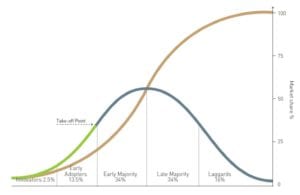 ng deeper into the data and drilling down into the model mix two things are starting to emerge, namely:
ng deeper into the data and drilling down into the model mix two things are starting to emerge, namely:
We can expect this trend to continue until there is a wider choice of BEV models for the consumer and charging infrastructure expanded. Let’s hope that this trend is not just another way for Big Auto to hijack and derail the drive to zero emission vehicles. In the meantime we should be grateful, that although not hardcore, PHEV’s still introduce new drivers to the pleasure of driving in full electric mode, thereby making them want a BEV next time they buy.
Notes on the data used for the study:
The page you requested could not be found. Try refining your search, or use the navigation above to locate the post.
We have designed some cool tools to compare electric vehicles. Our tools include a mobile app, charging cost calculator and EV selector. Use wattEV2Buy’s proprietary tools to find the ideal EV for your requirements and determine the cost of charging EVs.
wattEV2Buy’s easy to use EV Select tool helps identify which electric vehicle is perfect for your specific requirements. EV Select compare electric vehicles battery electric range over various vehicle types. Within four clicks you can get the perfect luxury sedan able to drive your required distance on battery power.
wattEV2Buy’s easy to use Charging Cost Calculator compare electric vehicles charging cost in your state and relate it to equivalent gasoline cost. The charging cost calculator also allows you to be specific and customize your electricity cost in kWh and provide results in miles and kilometers, making it usable all over the world.
Top 5 EV News Week 32 2020 | Cadillac Lyriq unveiled. Yet another Chinese EV startup IPO. Three new EV models launched this week.
Top 5 EV News Week 31 2020 | Successful IPO for CHJ Auto, Kandi finally enters the USA, Mitsubishi pays the cost for failing EV strategy.
Top 5 EV News Week 30 2020 | Chengdu Auto Show, Hozon Neta IPO, VW invest in China, eVito Tourer for sale
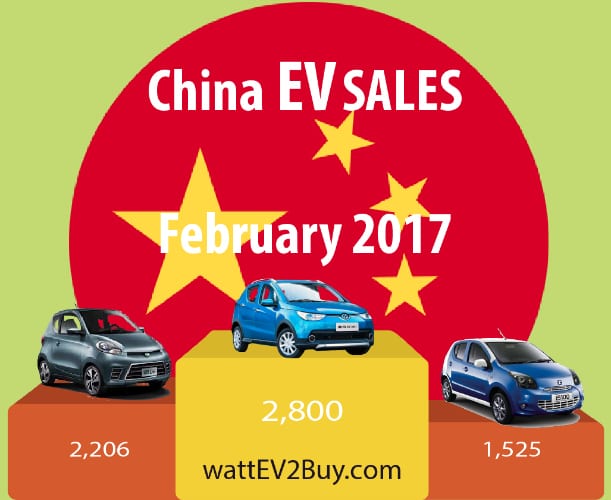
We all held our breath after the disappointing January EV’s sales from the world’s largest market in the sector. January sales were hit by a double whammy of the annual Chinese holiday season and a clamp down on subsidy fraud that plagued the Chinese EV sector, resulting in much stricter regulations by the Chinese Government.
February sales nearly tripled, with the new-comers the BAIC EC180 EV and SAIC Roewe eRX5 PHEV causing much of the stir. The SAIC Roewe SUV PHEV, introduced in the second half of 2016 is known as the Alibaba Connected Car, running Alibaba’s YunOS software, making the RX5 the world’s first internet car.
Small cars took the Top 4 positions for the month with the small hatchback BAIC EC180 outselling the rest by a long shot. The BAIC EC180, with a range of 180km at a top speed of 100km/h on a 41hp electric motor. BAIC remained the best performing brand for the year with total sales of over 5,000 units followed by SAIC Roewe.
BYD, China’s best-selling brand in 2016 with over 100,000 units from its five models, were the under performer with less than 2,500 units sold for the year-to-date. BYD is 10% owned by Warren Buffet’s Berkshire Hathaway.
BEV’s outsold PHEV by 3-to-1. Total sales in 2016 were 351,861 units, setting a huge target for the world’s largest EV market. Judging from the first two months sales, it seems difficult to breach.
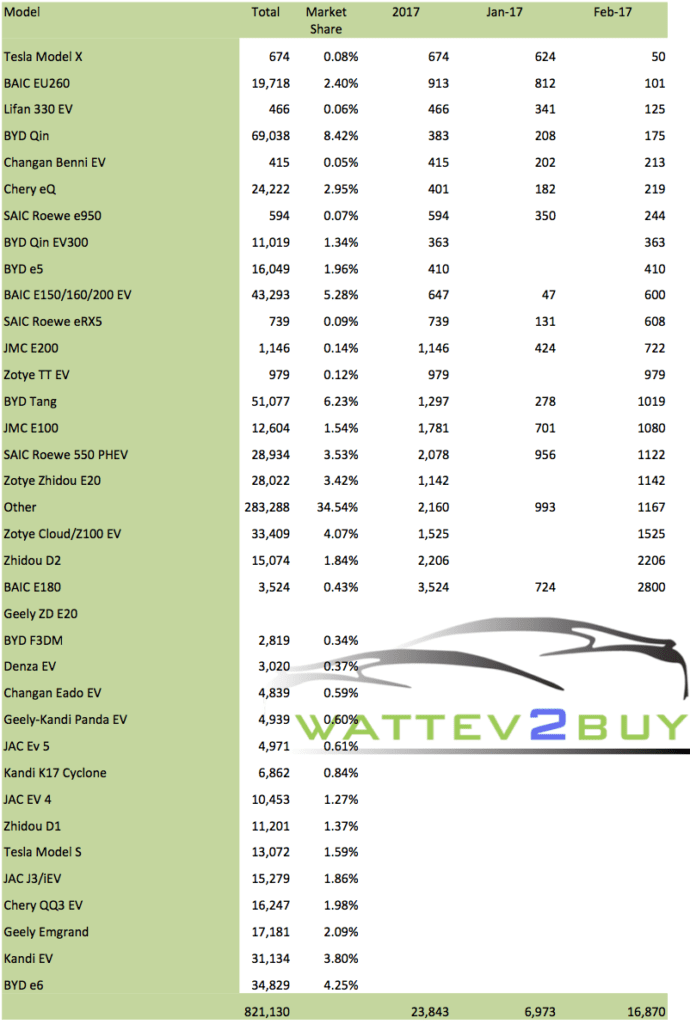
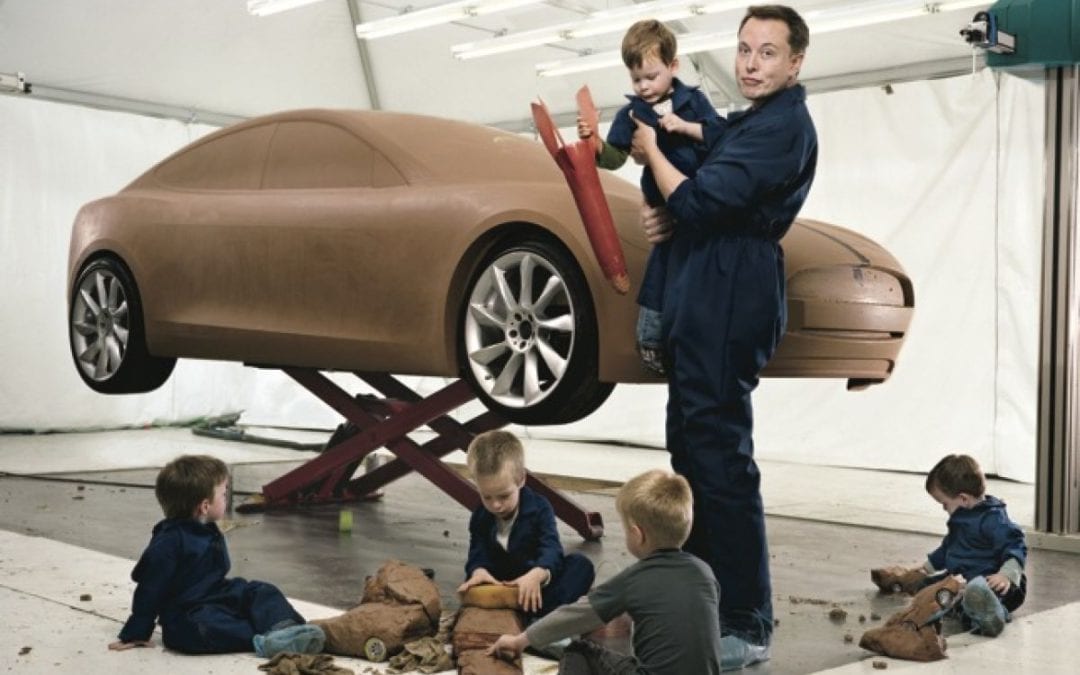
Electric vehicle sales have breached the 2 million unit mark internationally in 2016, and most automakers have committed to an electric vehicle strategy, some more aggressive than others and in the minority of cases not having a strategy is also seen to be a strategy. The Top 10 Electric Vehicle Brands constitutes a good proxy to evaluate trends within the market and to determine the reason for a brand’s success or failure. Also, as we reach the halfway mark to the point where electric vehicles are expected to reach between 9% and 11% of the total vehicle fleet by 2025, a look into the Top 10 will provide guidance on the expected winners and losers as the disruptive nature of the technology takes effect.
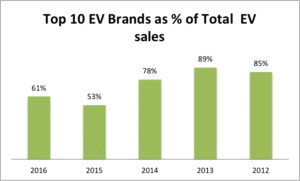
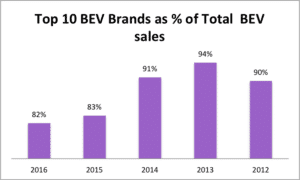
Sales of the Top 10 Electric Vehicle Brands constitute 65% of all electric vehicle (EV’s) sales, and for the Top 10 BEV list, 85% of all pure electric or Battery Electric Vehicles (BEV’s) are from the Top 10 Brands in the segment. However, the trend on both lists is on the decline as more and more brands participate in the market. The Top 10 Brands in the pure electric space owns a bigger percentage of the market segment as BEV’s requires more specialization and greater risk. Due to the high cost of battery technology and range anxiety, most automakers excluded themselves from the pure electric segment, providing a golden opportunity for a few dedicated brands to seize the opportunity and leapfrog their competitors into the coming decade.

The following interesting point emerges when comparing the Top 10 Electric Vehicle Brands positions in 2012 with the overall standings and the latest standings in 2016:

Looking at the Top 10 Electric Vehicle Brands list when one only include Battery Electric Vehicles an entirely different picture emerges in many respects:
With EV sales rapidly climbing in 2016 and countries such as Norway now reaching EV sales of over 30% of new vehicles, owning an EV is not just an environmental requirement anymore drawing early adopters. Owning an EV’s has become cool and entering the growth phase in markets such as Norway and The Netherlands, where a couple of “Big Auto” manufacturers have opted to target the mainstream market through bringing Plug-In Hybrid versions of existing models. Many of the “Big Auto” brands are play stalling tactics by calling for the easing of emission standards or blocking Tesla’s direct sales model. Meanwhile, they are falling further and further behind in a market that is becoming ever more popular. Most of these manufacturers might be of the 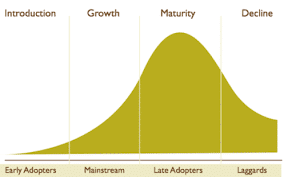 opinion to follow a wait and see approach, hoping that the first mover’s trips and falls due to the high risk and cost, with the intention to swoop in later with their big budgets to poach talent and ideas. We will analyze the tussle between Battery Electric Vehicles and Plug-in Hybrid Electric Vehicles in a follow-up post.
opinion to follow a wait and see approach, hoping that the first mover’s trips and falls due to the high risk and cost, with the intention to swoop in later with their big budgets to poach talent and ideas. We will analyze the tussle between Battery Electric Vehicles and Plug-in Hybrid Electric Vehicles in a follow-up post.
Picture Ellon Musk: The New Yorker

The disruption caused by the threat of electric vehicles is finally hitting home. In no other week has news related to the pushback by the proxies of the affected parties been so prominent than the past week, at a time when electric vehicle sales and forecasts are surprising the market on the upside. The frantic efforts of Big Auto and Big Oil to reverse progress is right out of a scene from Godfather 3, when Michael Corleone reflected “Just When I Thought I Was Out, They Pull Me Back In.”
The efforts to block the march of electric vehicles has reached new heights as old foes Big Corn, and Big Oil agreed to work together in defending the transportation fuel sector. Reuters reports the Renewable Fuel Association (AFR) and American Fuel and Petrochemical Manufacturers (AFPM) will target electric vehicle incentives to “level” the playing fields. We hope the AFR and AFPM remember all the subsidies and support they received over the years to “level” the playing fields.
The Sierra Club, a respected environmental association, reported on the drive by various States to penalize electric vehicle owners. The report speculates that the efforts, already successful in ten States and considered in a further six, is backed by the Oil Industry. The Koch Brothers, Charles, and David, who’s combined wealth of $79Bln gained from oil, making them richer than the world’s richest person, Bill Gates, funded the creation of the American Legislative Exchange Council (ALEC) in 2015. ALEC’s mission is to discourage States to support electric vehicles for carbon fuel based transport. Only four States, Texas, Oregon, Vermont, and Wisconsin have been successful in blocking the attack. Penalties take the form of annual fees varying between $50 and $300 per year. Georgia, which at some point had the 2nd highest EV sales in the USA as a result of a tax incentive of $5,000, replaced the subsidy with a $200 annual fee, resulting in an 80% drop in EV sales.
In a separate effort, the Alliance of Automobile Manufacturers asked President Trump’s newly appointed Environmental Protection Agency Tsar, Scott Pruitt, to withdraw the Obama era agreed on 54.5MPG emissions benchmark, required by 2025. The AAM’s reasoning is that achieving the standard is too costly and that the consumer demand is not there to support such a stringent rule. Really? The obvious question one should ask AAM is how they think the consumer could demand EV’s if the supply of combustion vehicles is stuffed down their throats? Looking at the list of auto manufacturers supporting this effort, it begs the question if brands such as GM only manufacture models such as the Bolt as a compliance vehicle, a viewpoint held by many in the electric vehicle fraternity. Developing EV’s only for compliance purposes limits consumer choice and the advancement of the technology. Already GM is slated for only launching the Bolt in States where there are emission standards. The reality is that these brands have been against the technology from the start and now find themselves threatened and at a disadvantage, having to resort to delaying tactics at the cost of the environment and consumer.
In Hong Kong, a mainstay market for Tesla, the Financial Secretary in his budget announced that the 20-year-old tax incentive for first-time EV registrations would be scrapped, and the tax discount on electric vehicles be capped at around $12,500. The result is that the cost of a Tesla Model S could nearly double in price. The move is in a bid to limit overall car ownership.
Post from watteEv2Buy Top EV News Weeks 8 of 2017
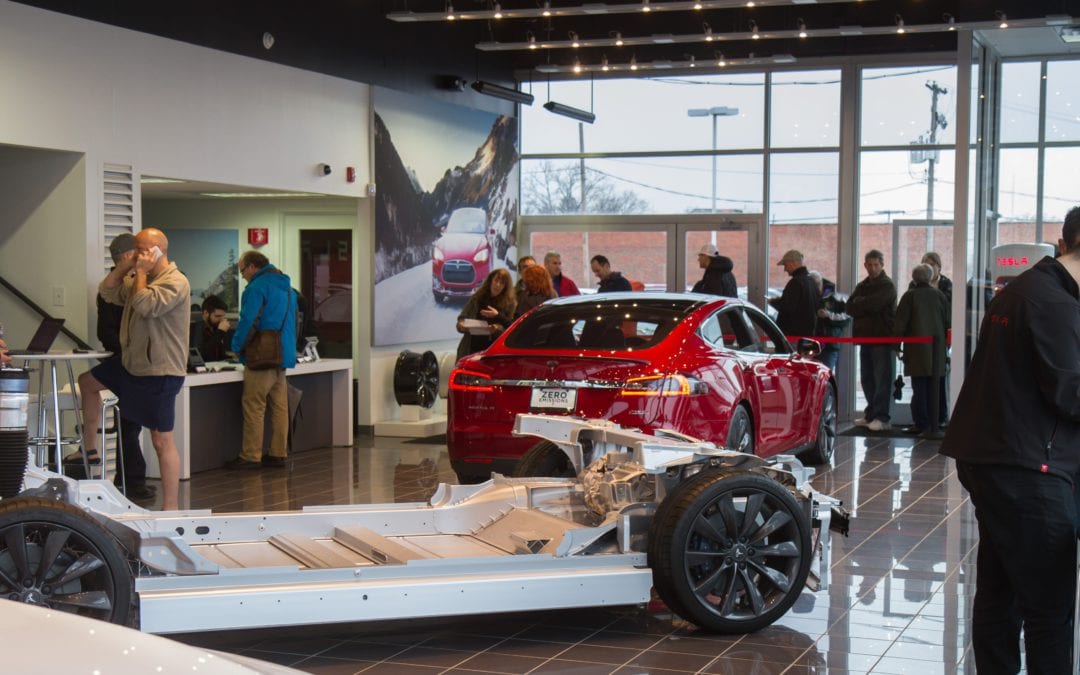
Tesla voted the consumers darling in the Consumer Reports Annual Owner Satisfaction Survey with 91% Tesla owners responded with a “Definitely yes” when asked if they will buy the brand again. Second with only 84% was Porsche. The bottom quartile included brands such as Jeep, Nissan, Fiat, and Volkswagen, which dropped eight places. The survey included over 300,000 vehicles. Can the States who is refusing Tesla’s direct selling model, naysayers, and auto dealers refusing to get behind electric vehicles please respond to this? For the complete list follow the link.
The UK electric car market is showing good momentum with just under 20,000 new plug-in registrations in the first half of 2016. This is a 31.8% increase on the same period in 2015 and more interestingly there was a 38% like for like increase in the second quarter of 2016. There is no doubt that the UK electric car market is going from strength to strength, total registrations since 2011 are nearing 70,000, and the UK government is playing its role in this growth. So, what can we expect in the future and will the UK electric car market lead the European sector?
The two most popular vehicles in the first half of 2016 were the Mitsubishi Outlander PHEV and the Nissan Leaf both of which are recognised as leaders in their field. Perhaps one of the other interesting factors of late is the ever-increasing competition across the electric vehicle market which is giving consumers more choice. This increase in choice can only benefit the sector going forward and we are starting to see some of the biggest names in automobile manufacturing stepping up to the EV mark. (more…)
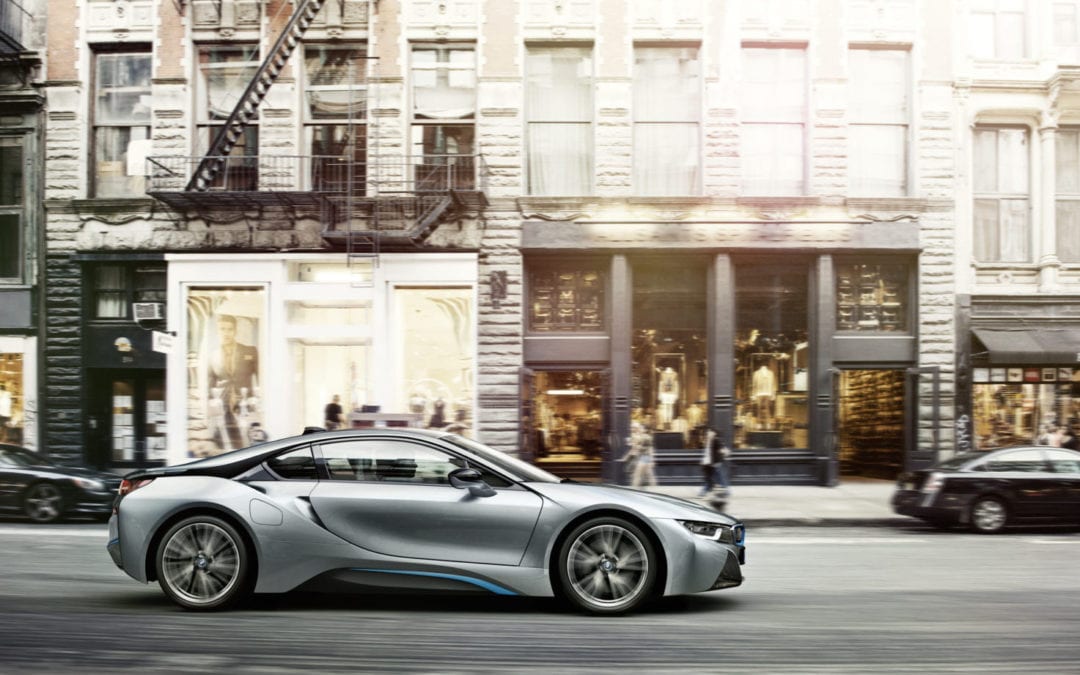
The US automobile industry has in many ways been a law unto itself for decades now although young EV upstart Tesla Motors is determined to take on the might of the archaic US dealership system. While the original idea of dealership only automobile sales across the US was well-balanced, protecting consumers and independent dealerships from the might of the automobile giants, the Internet has changed the playing field. Many have tried and failed to overturn this ancient system but the outcome of a forthcoming Supreme Court battle in Utah could have significant ramifications for the future.
Dealership associations up and down the US dominate and effectively dictate the way in which automobiles are sold. Restrictive direct sales laws in states such as Texas, Connecticut, Michigan, Indiana, Utah and others have not help the development of the electric car industry. The idea behind this system was to offer consumers a local contact point for issues, enquiries, spare parts, etc and effectively outlaw long-distance selling. However, the online sales arena has had an impact upon nearly every area of business life although the automobile industry is the last one to hold out! (more…)